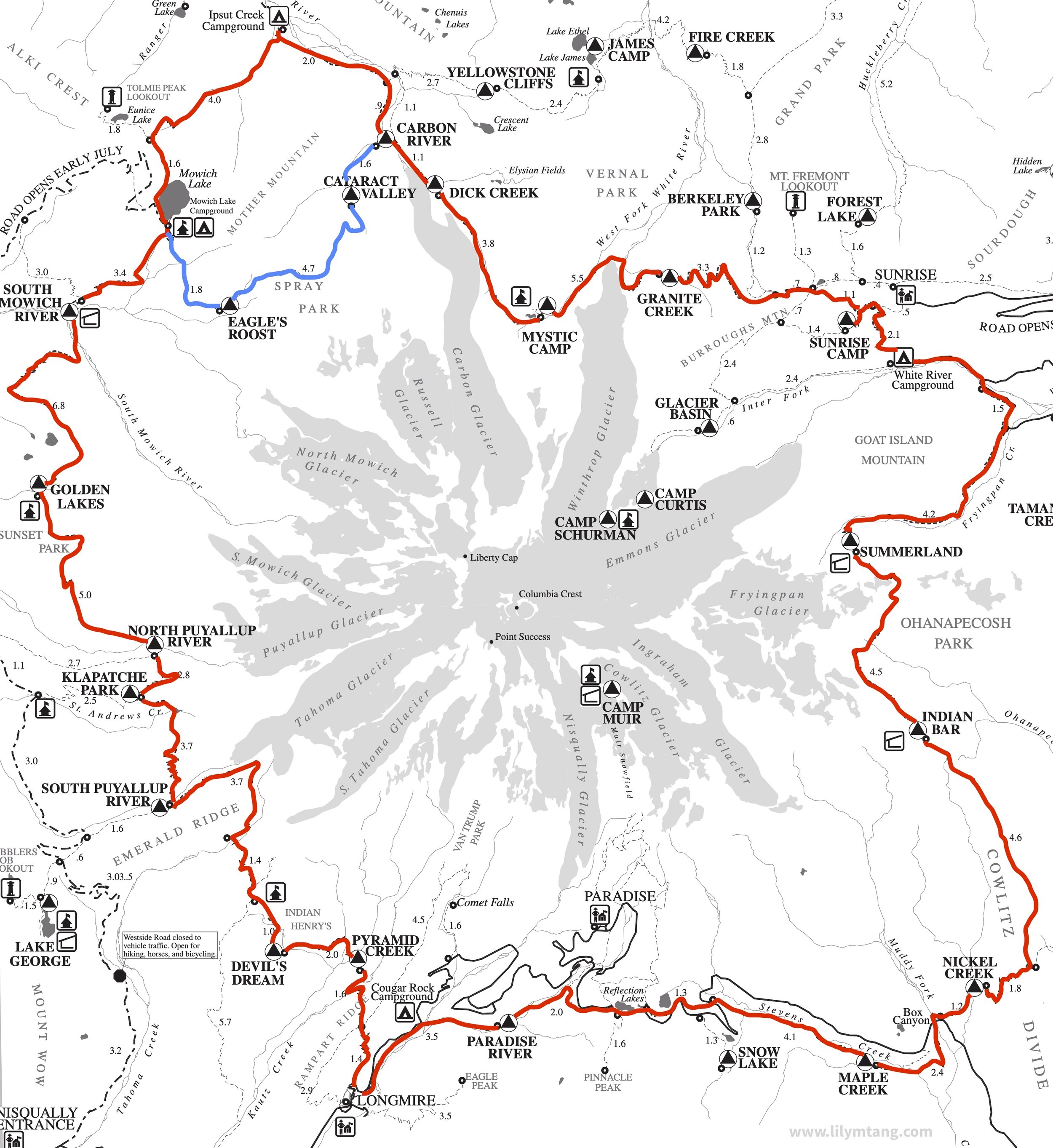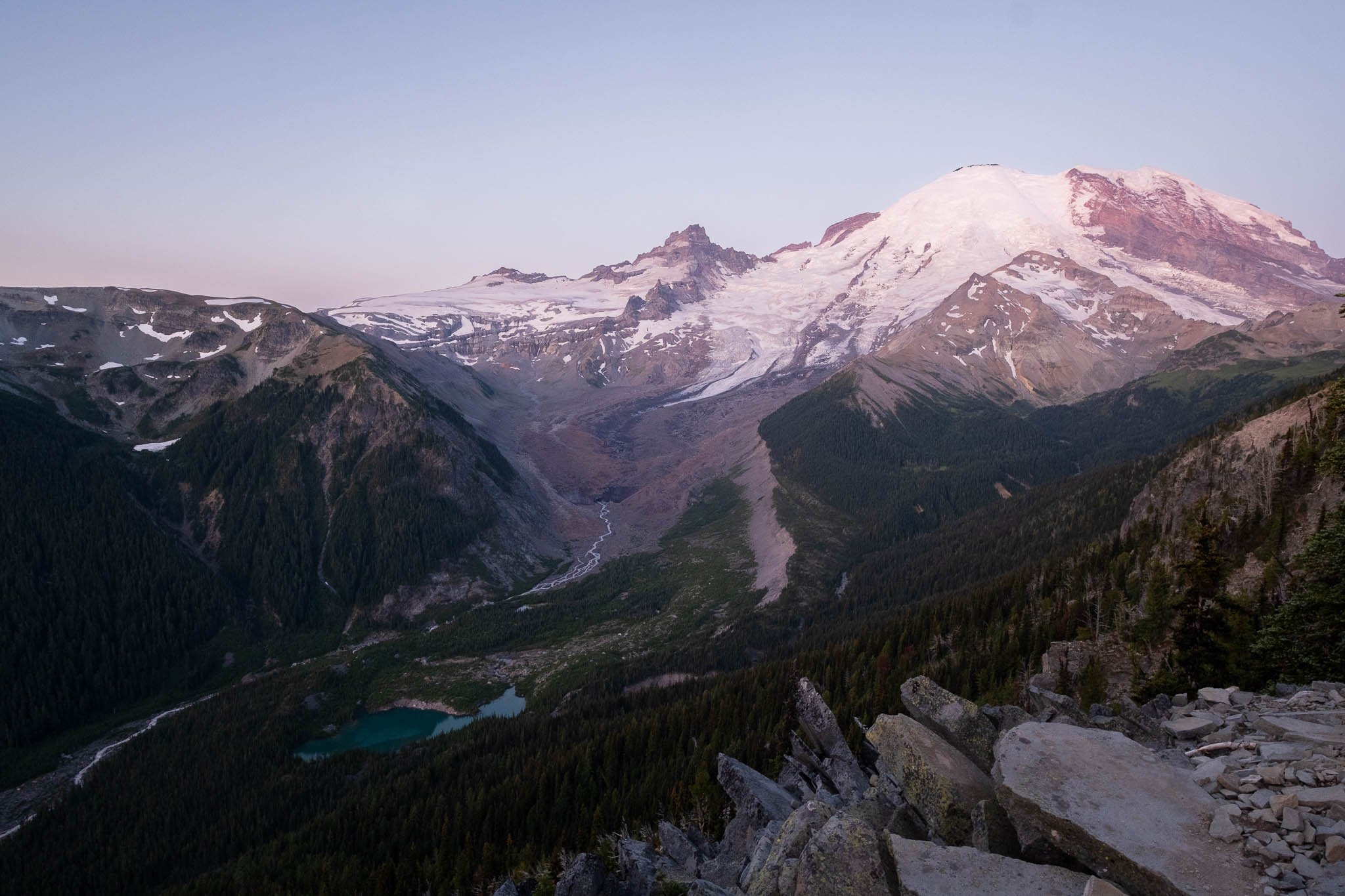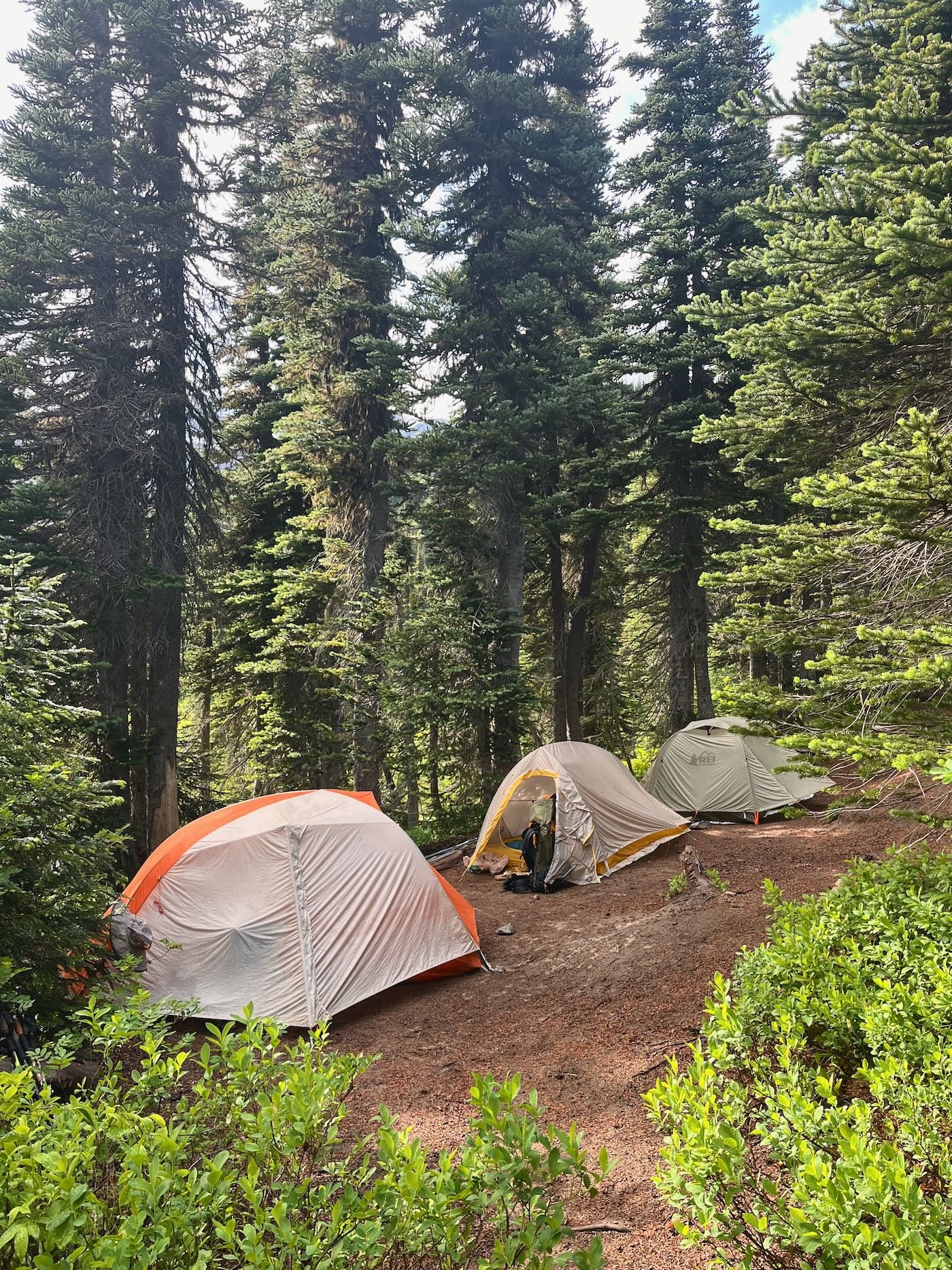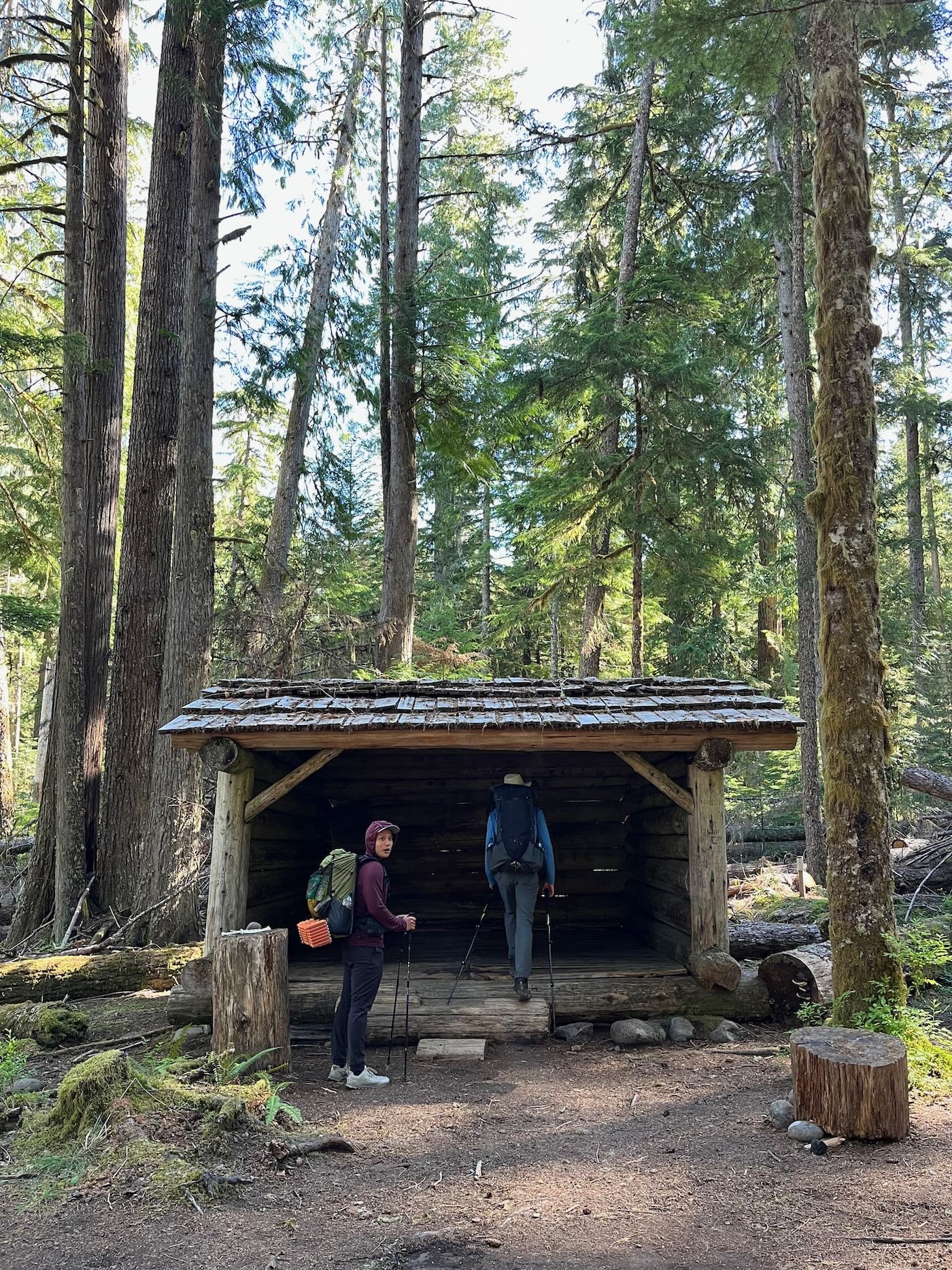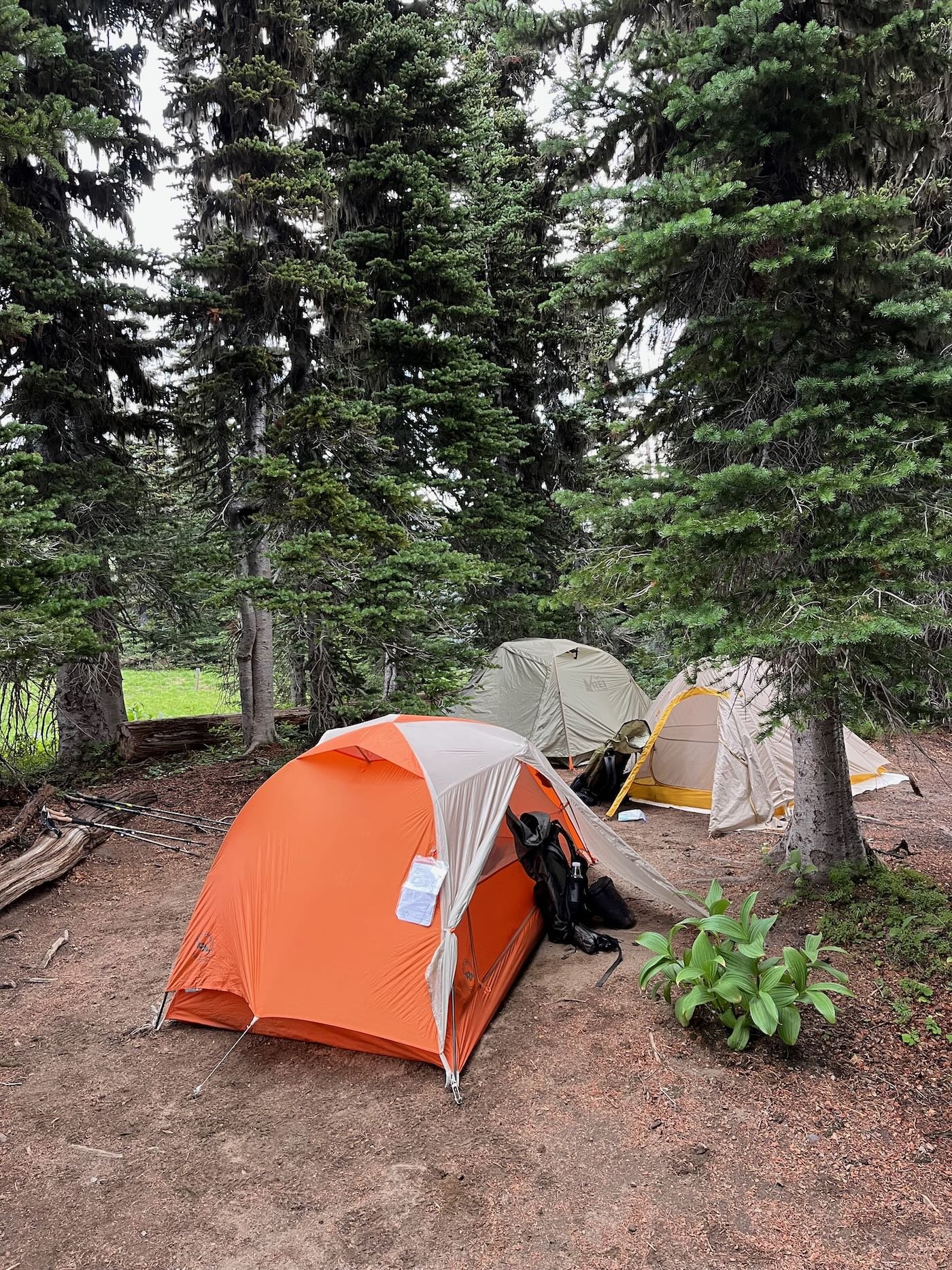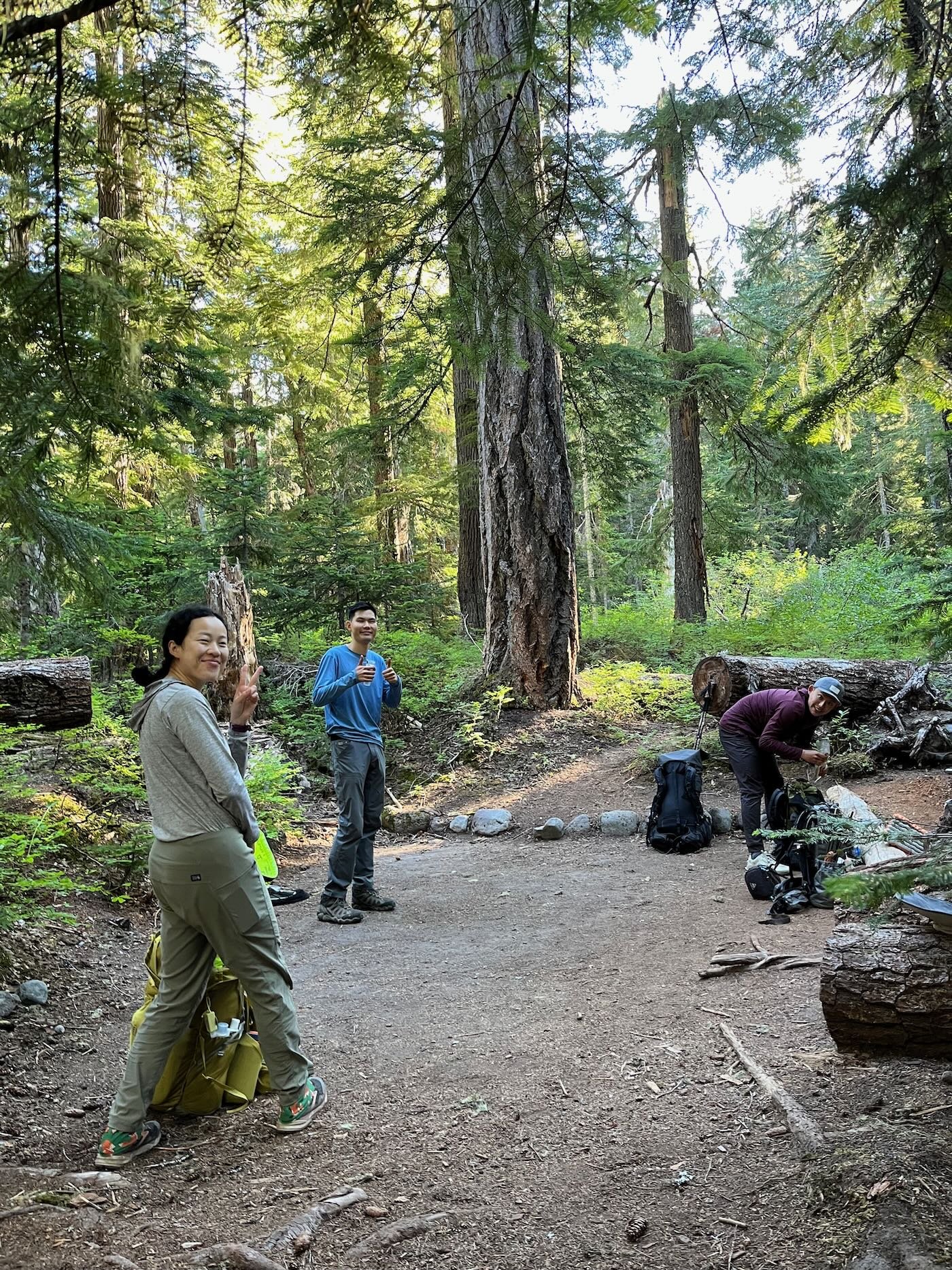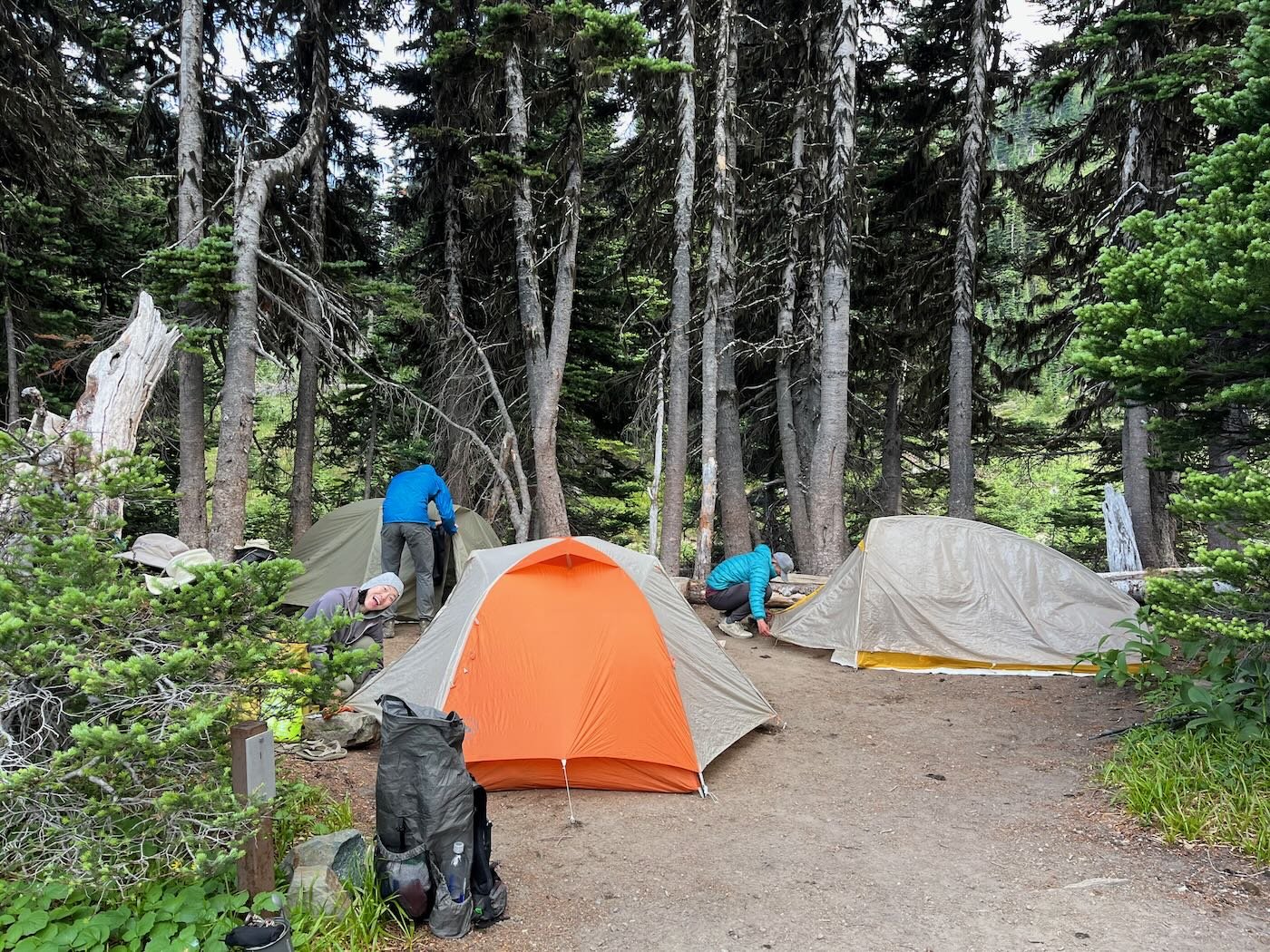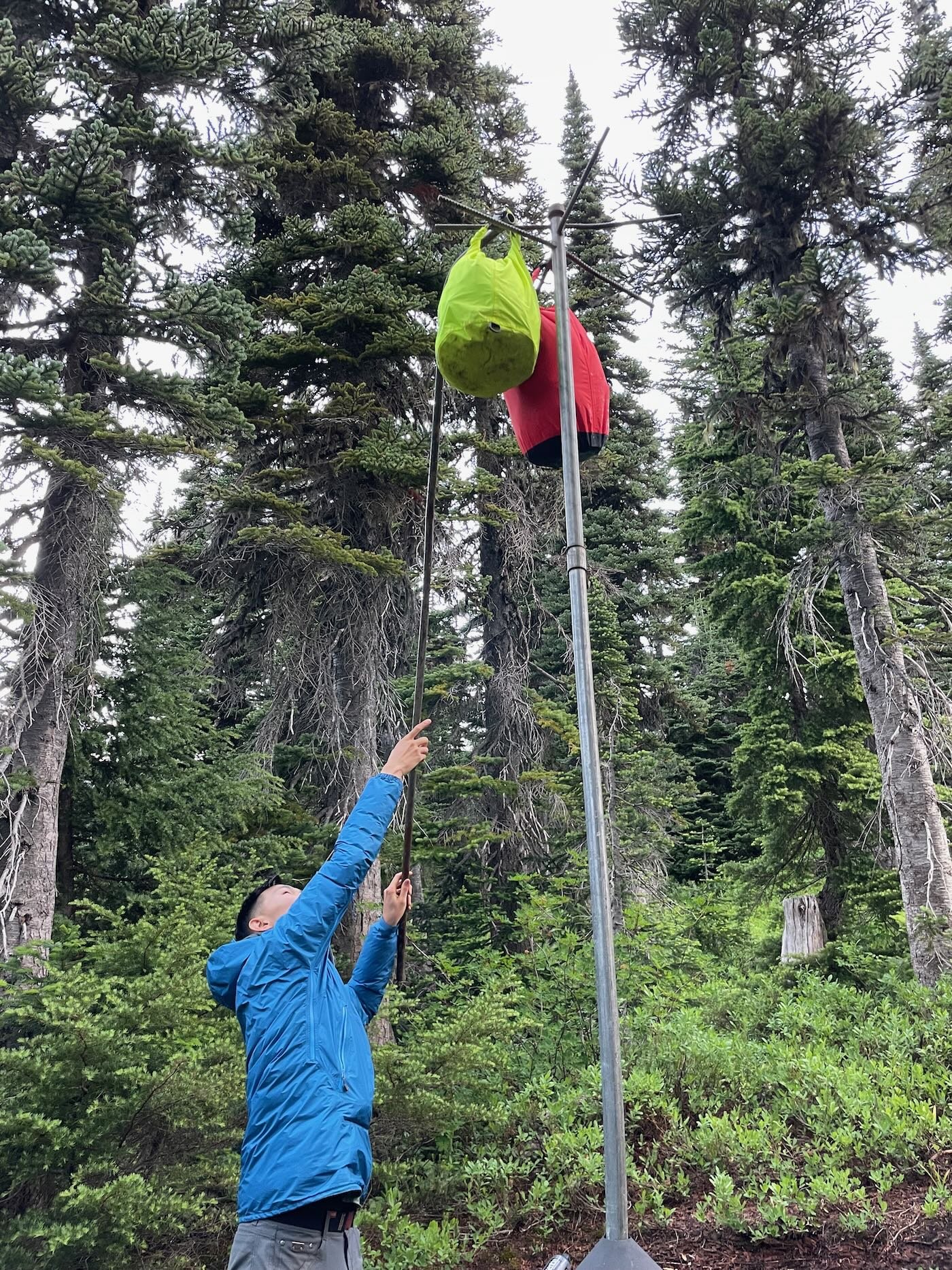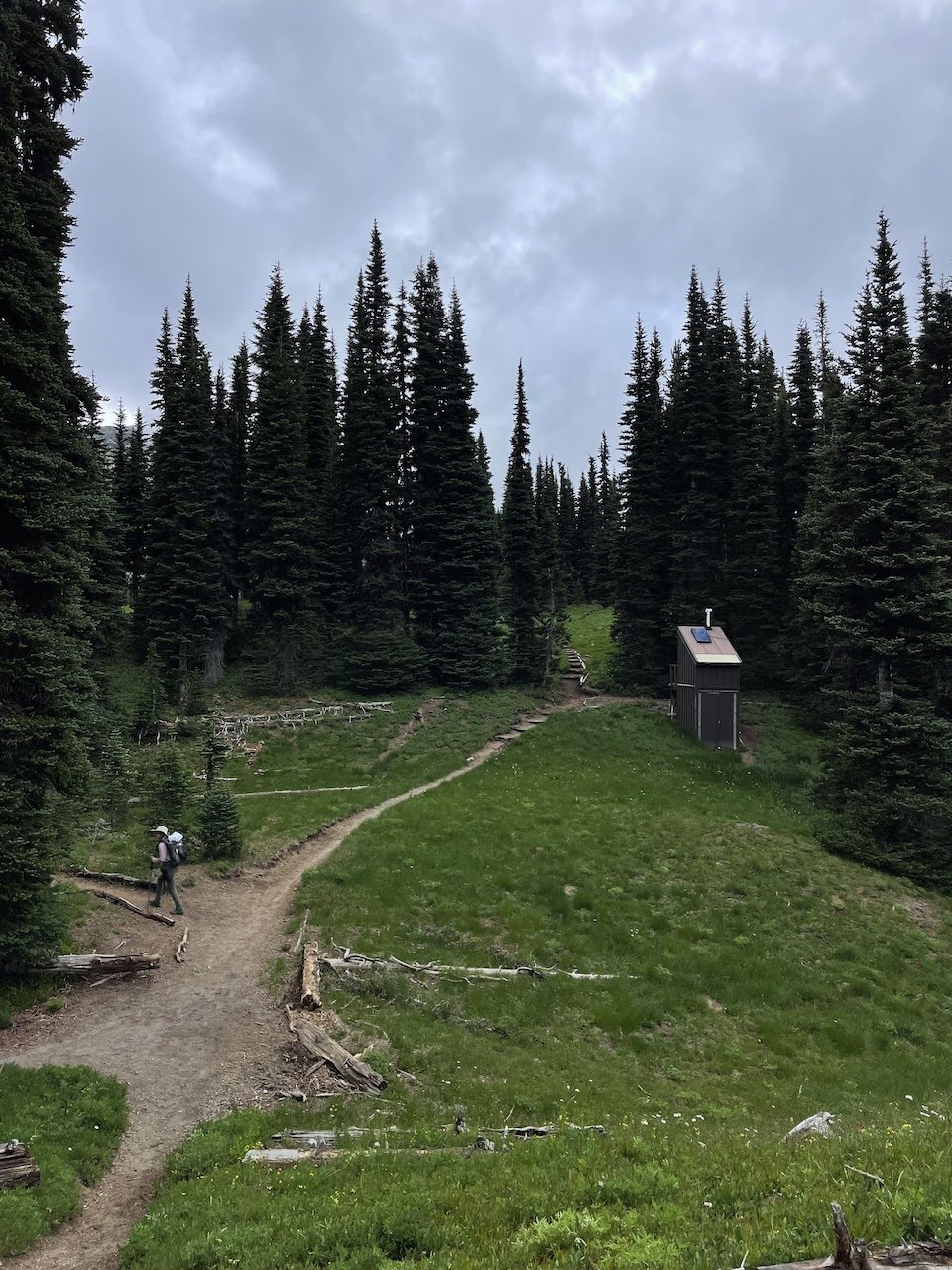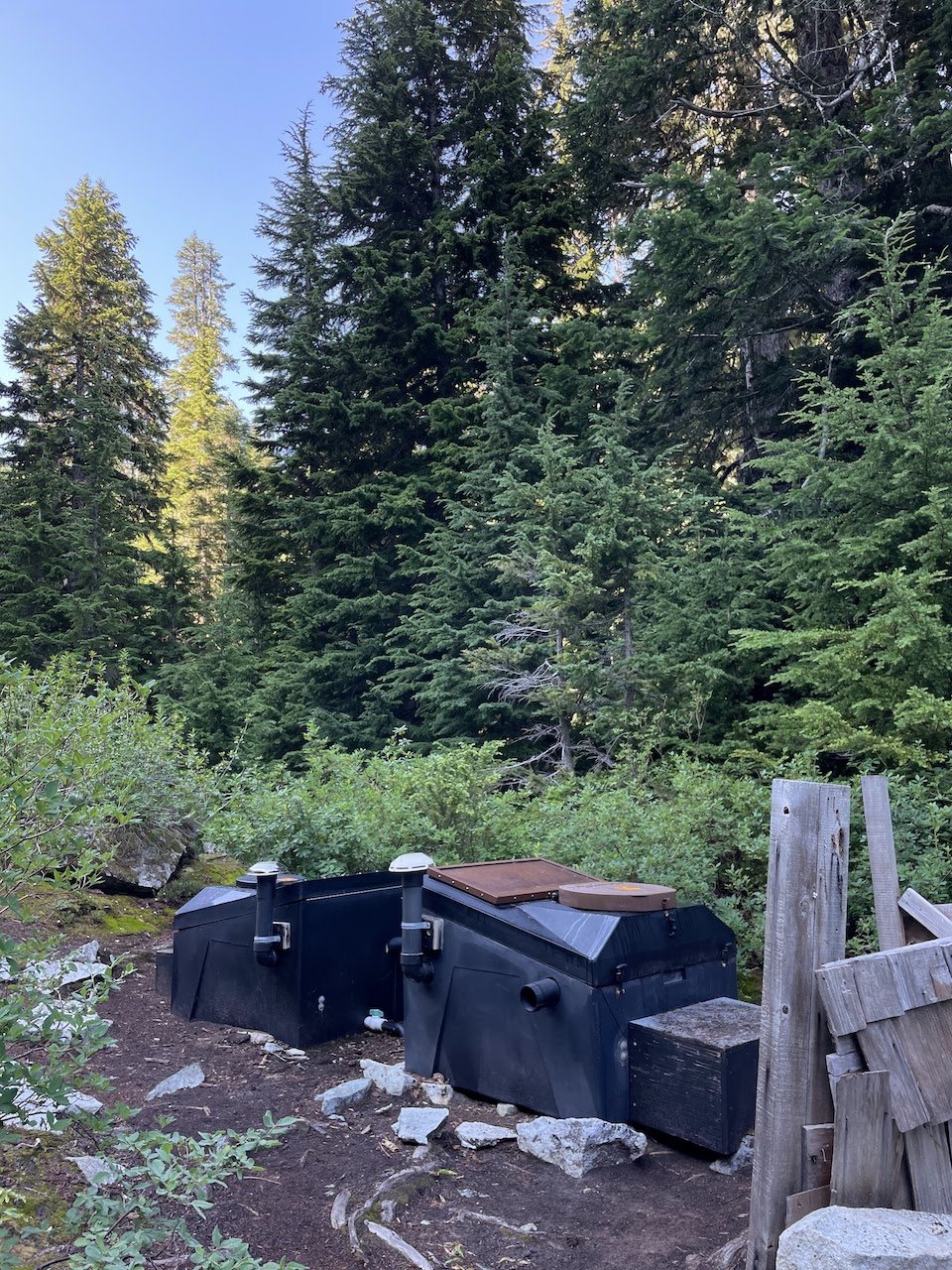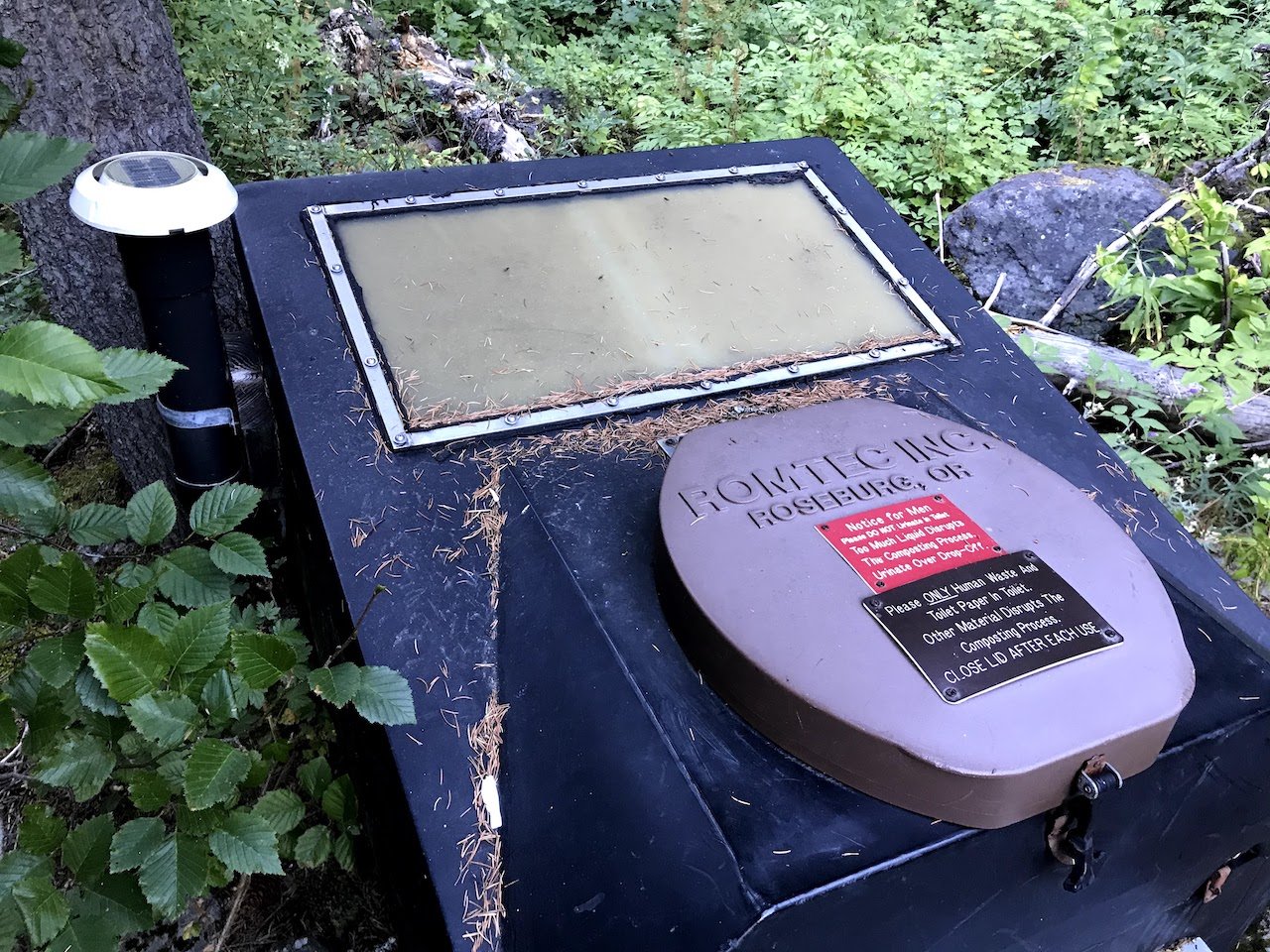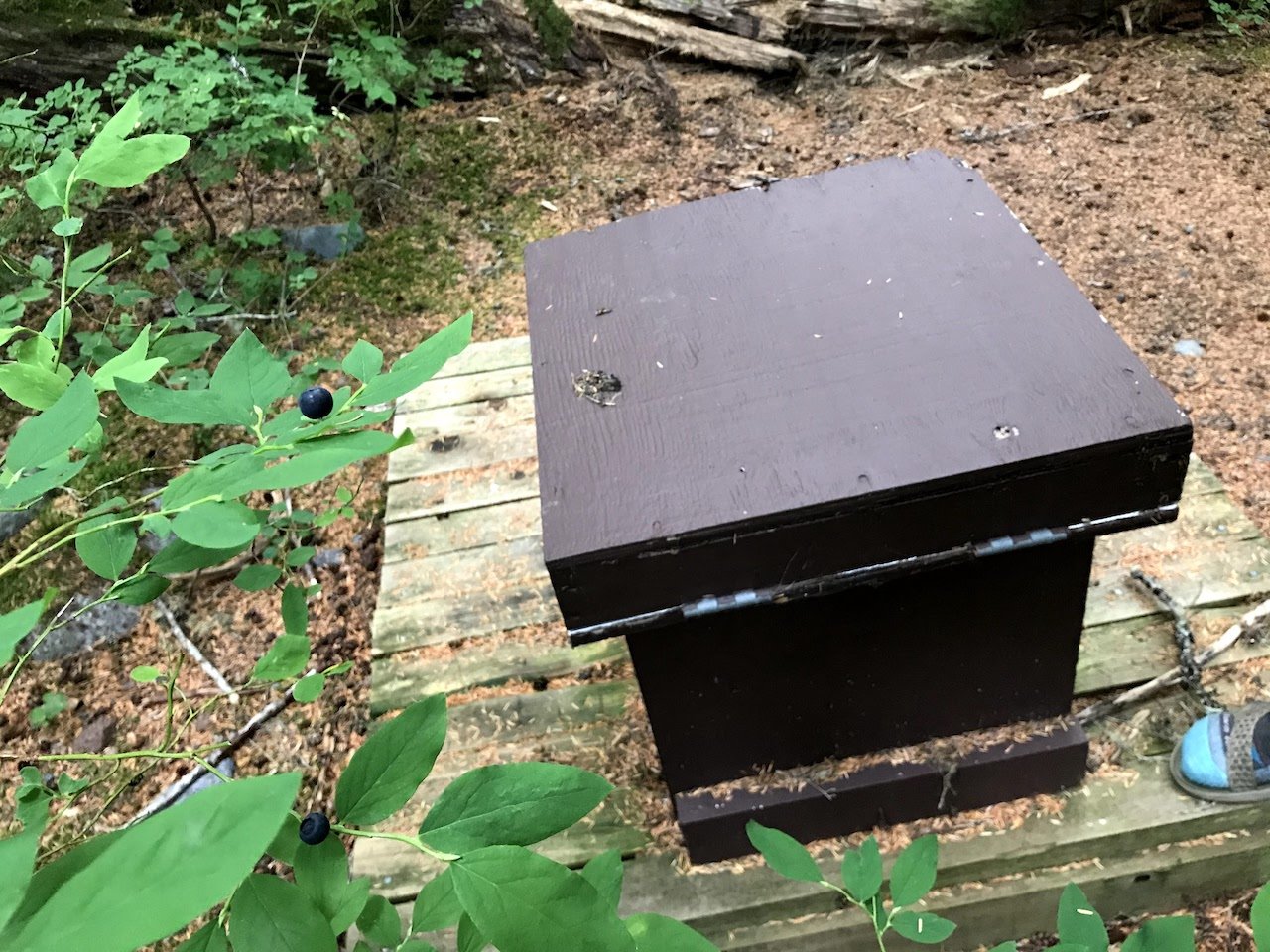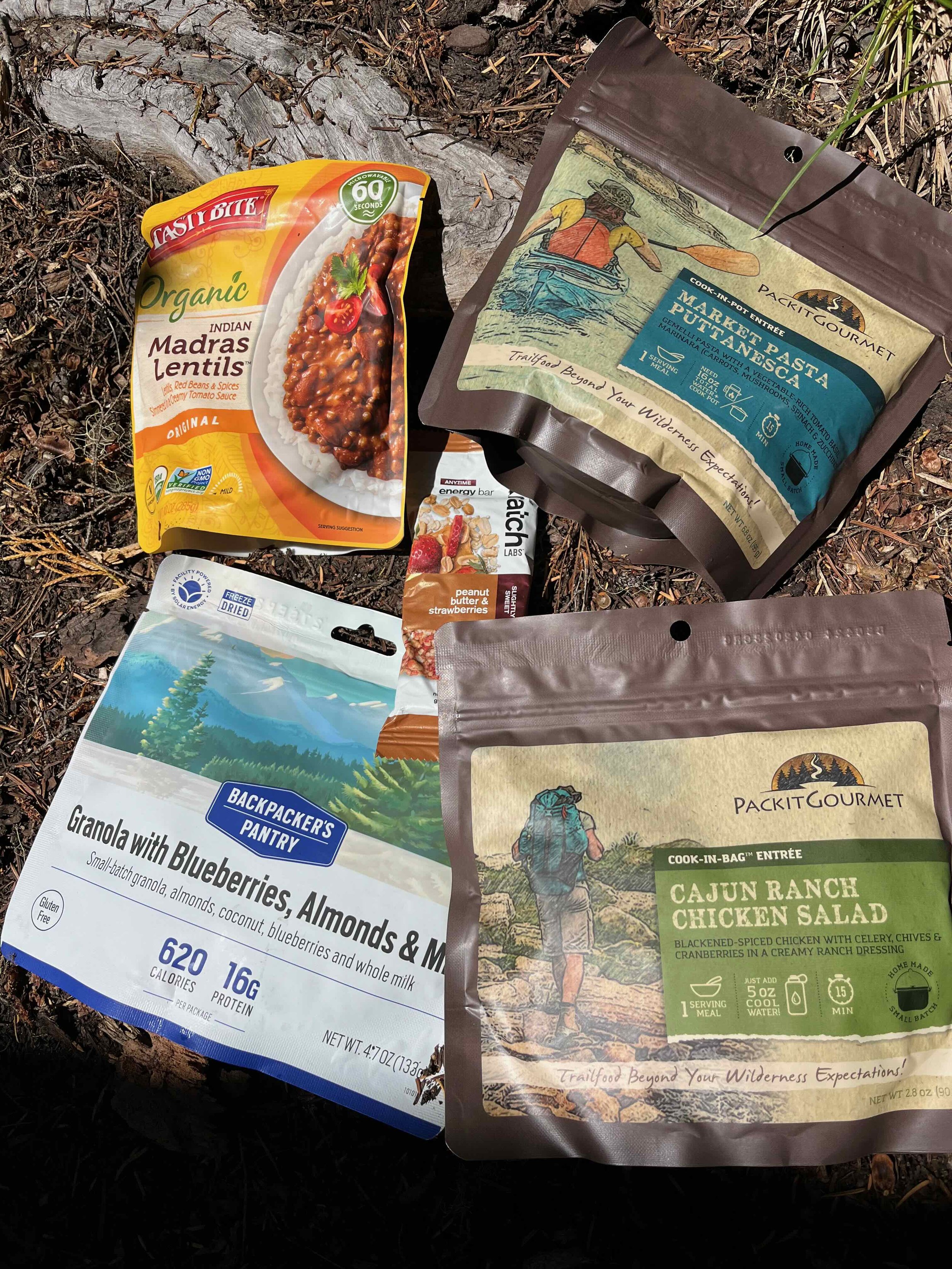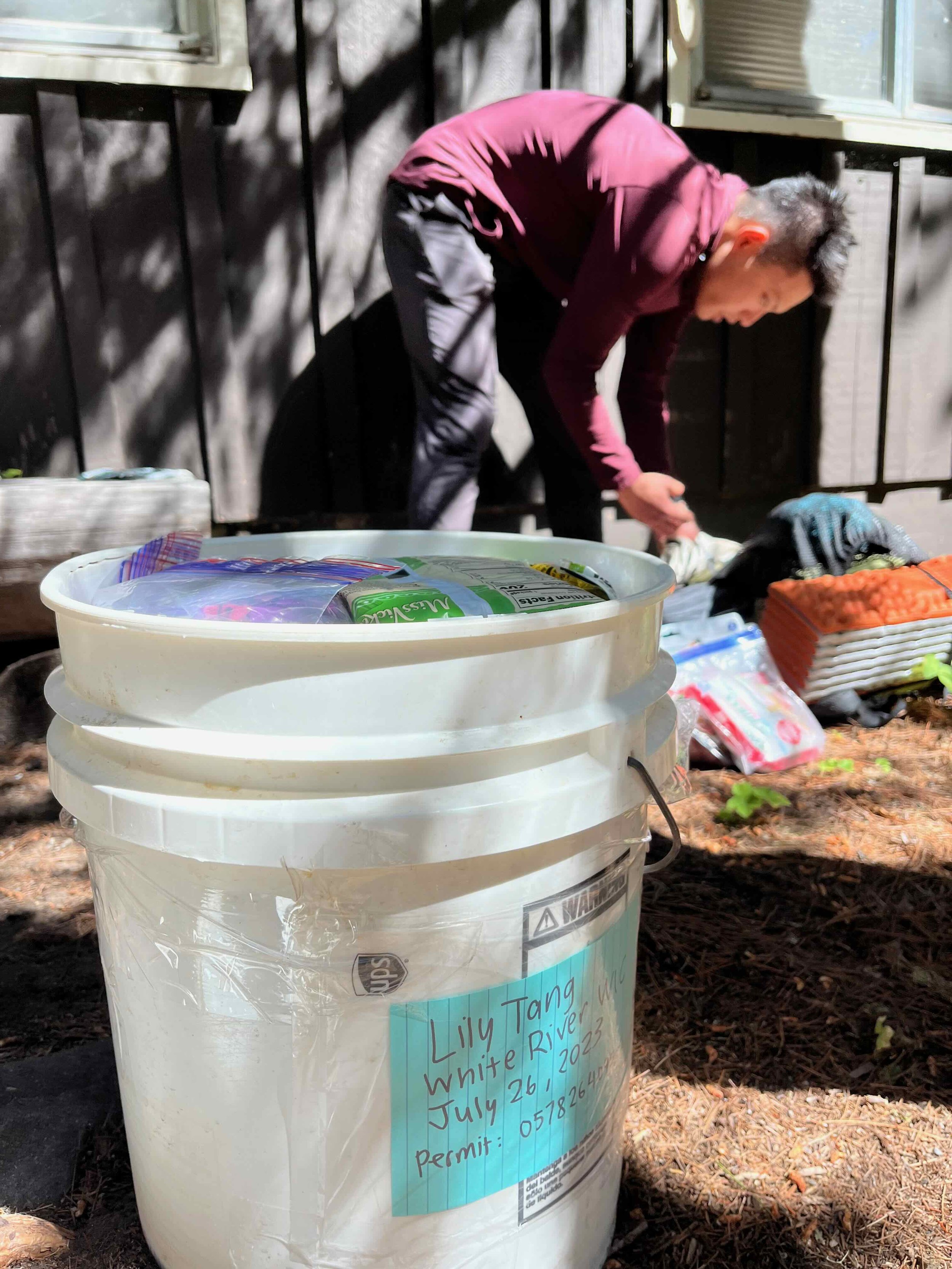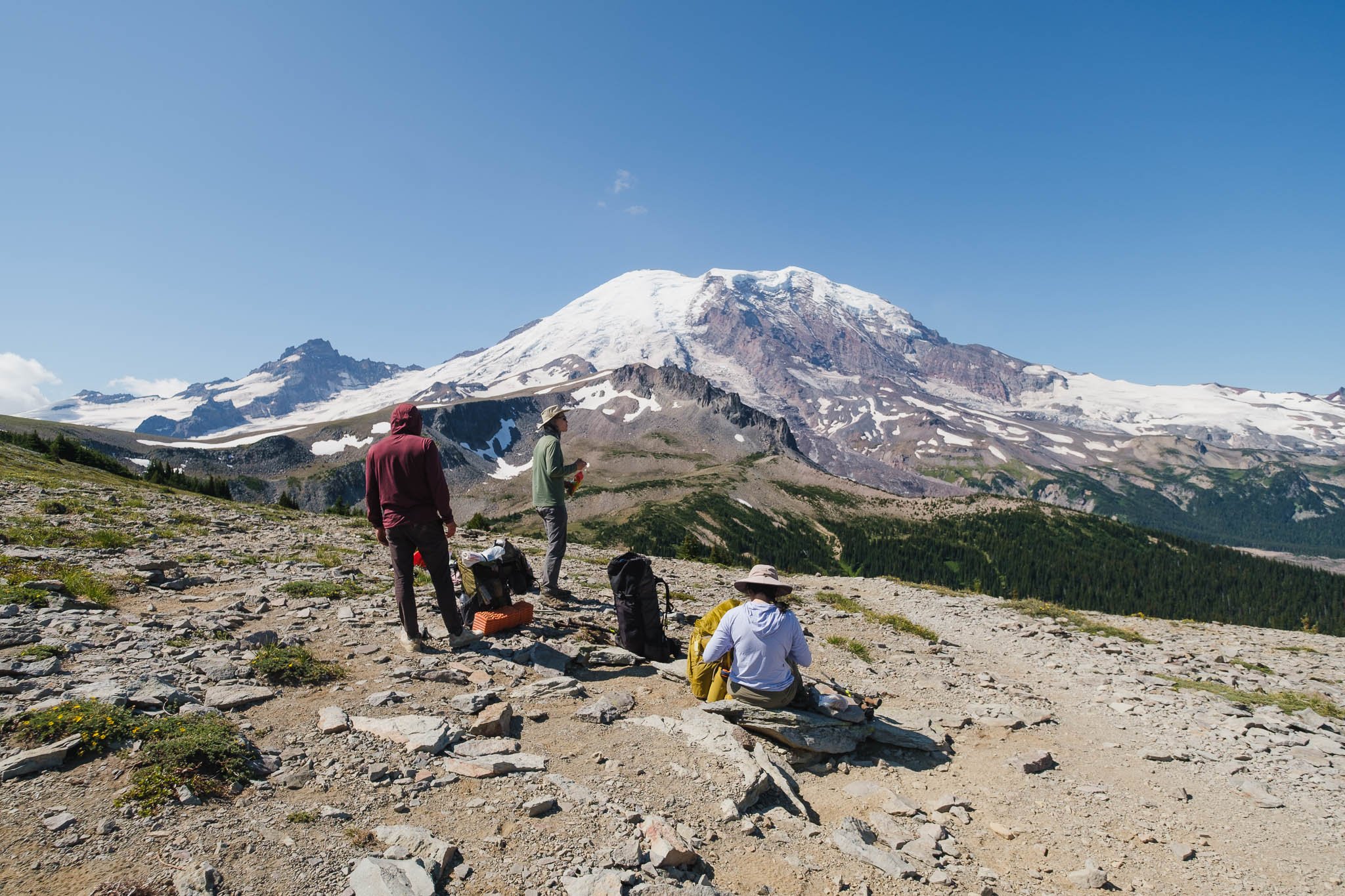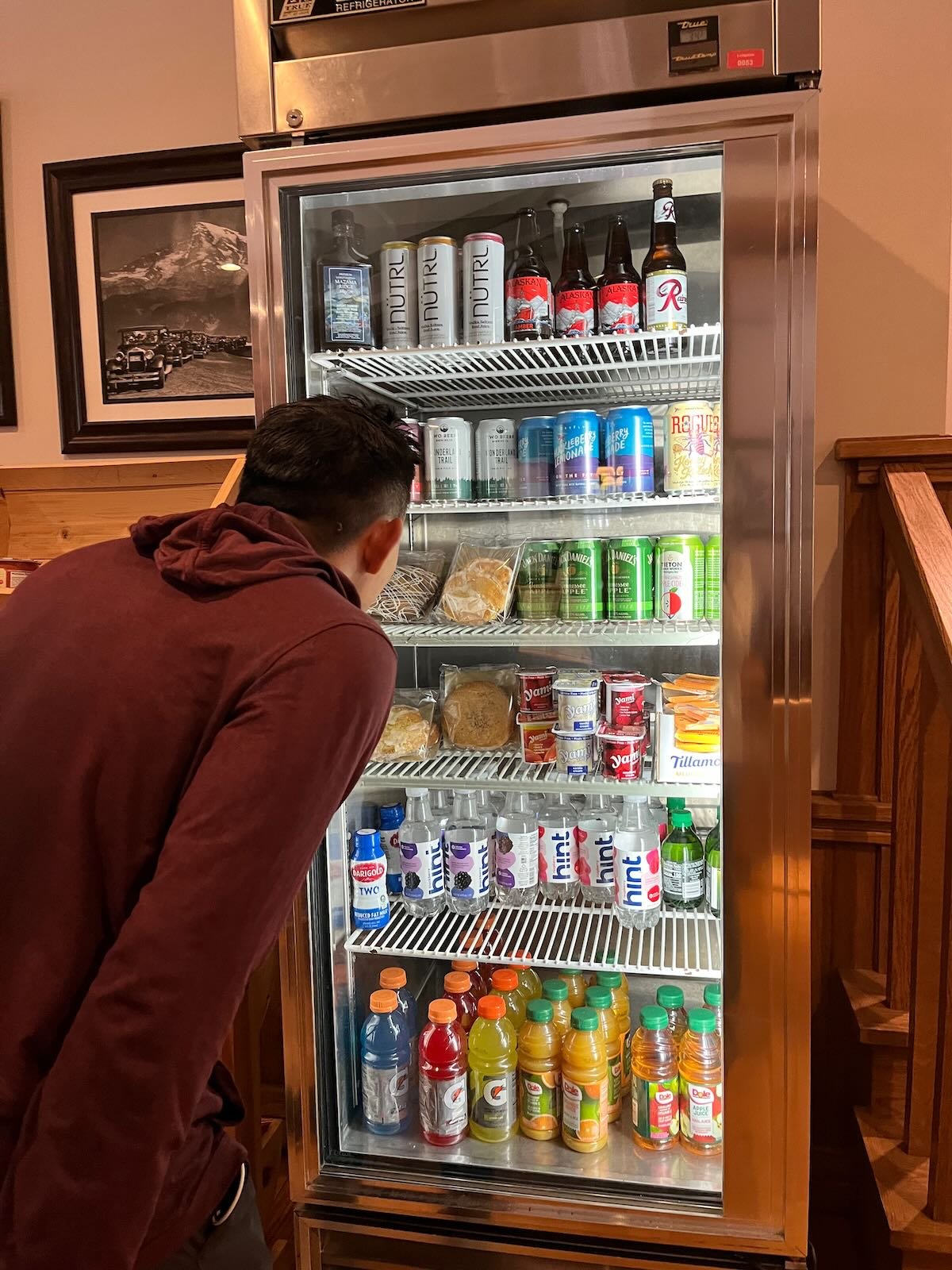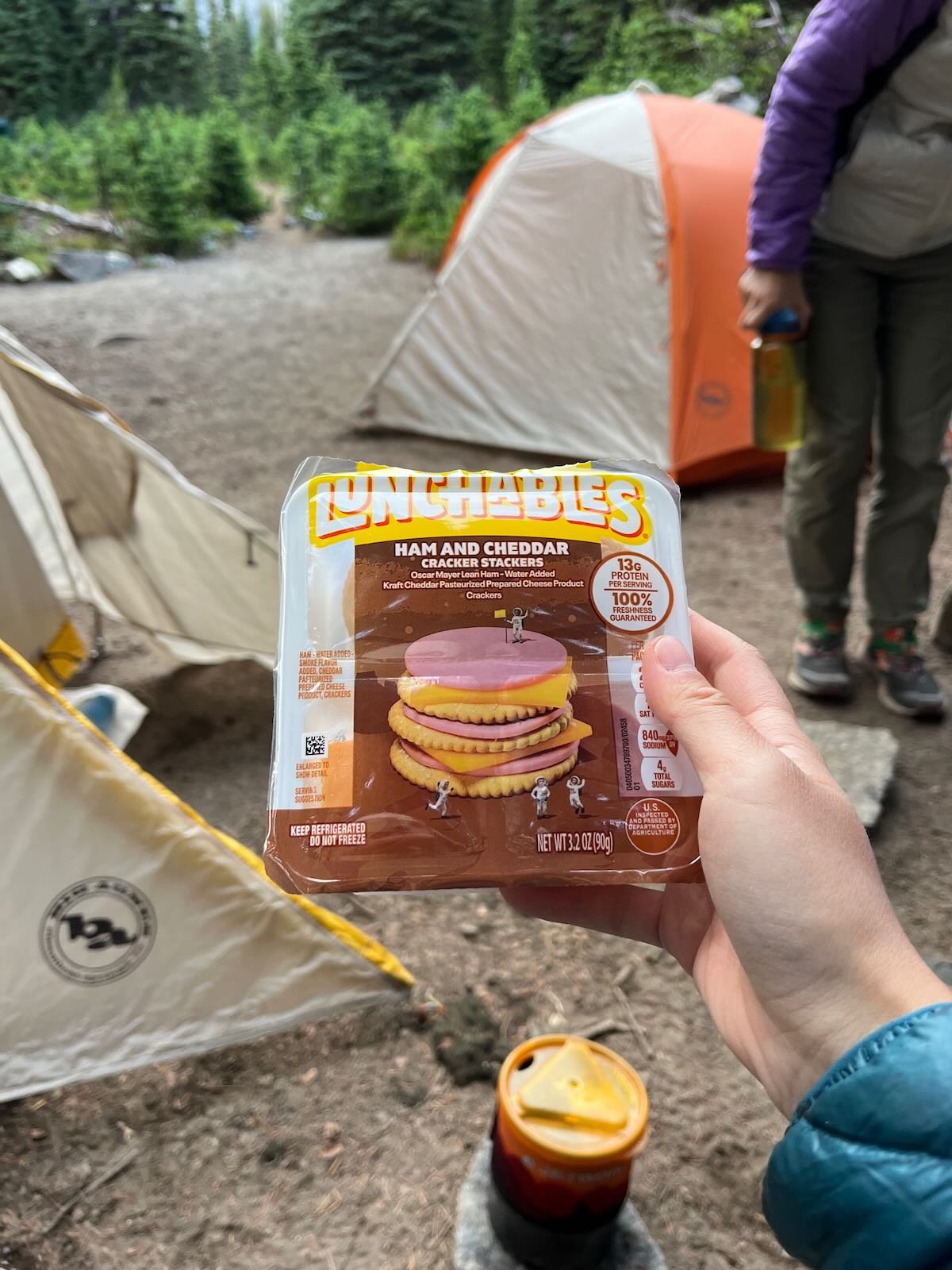Guide to Thru-Hiking the Wonderland Trail
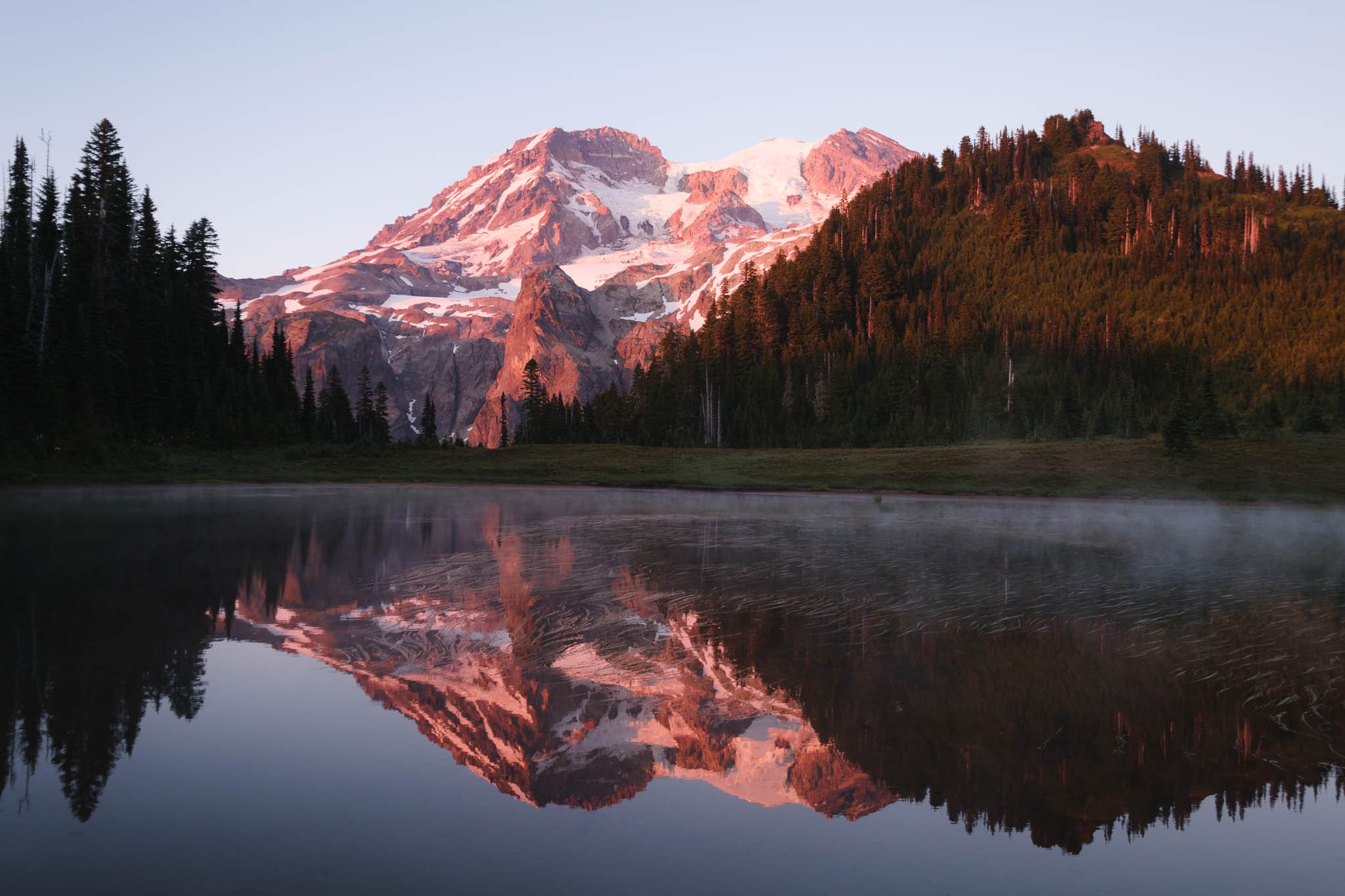
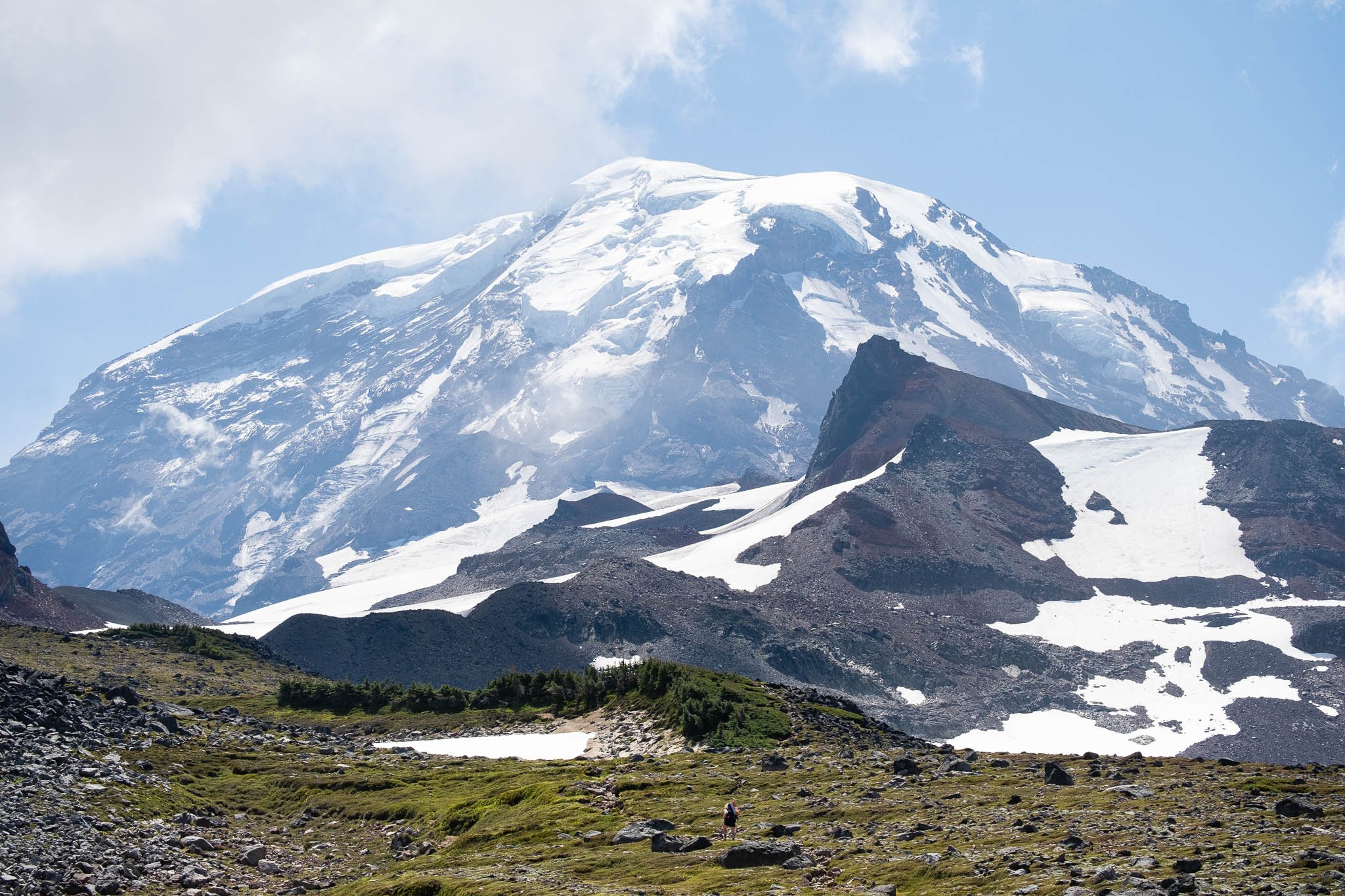
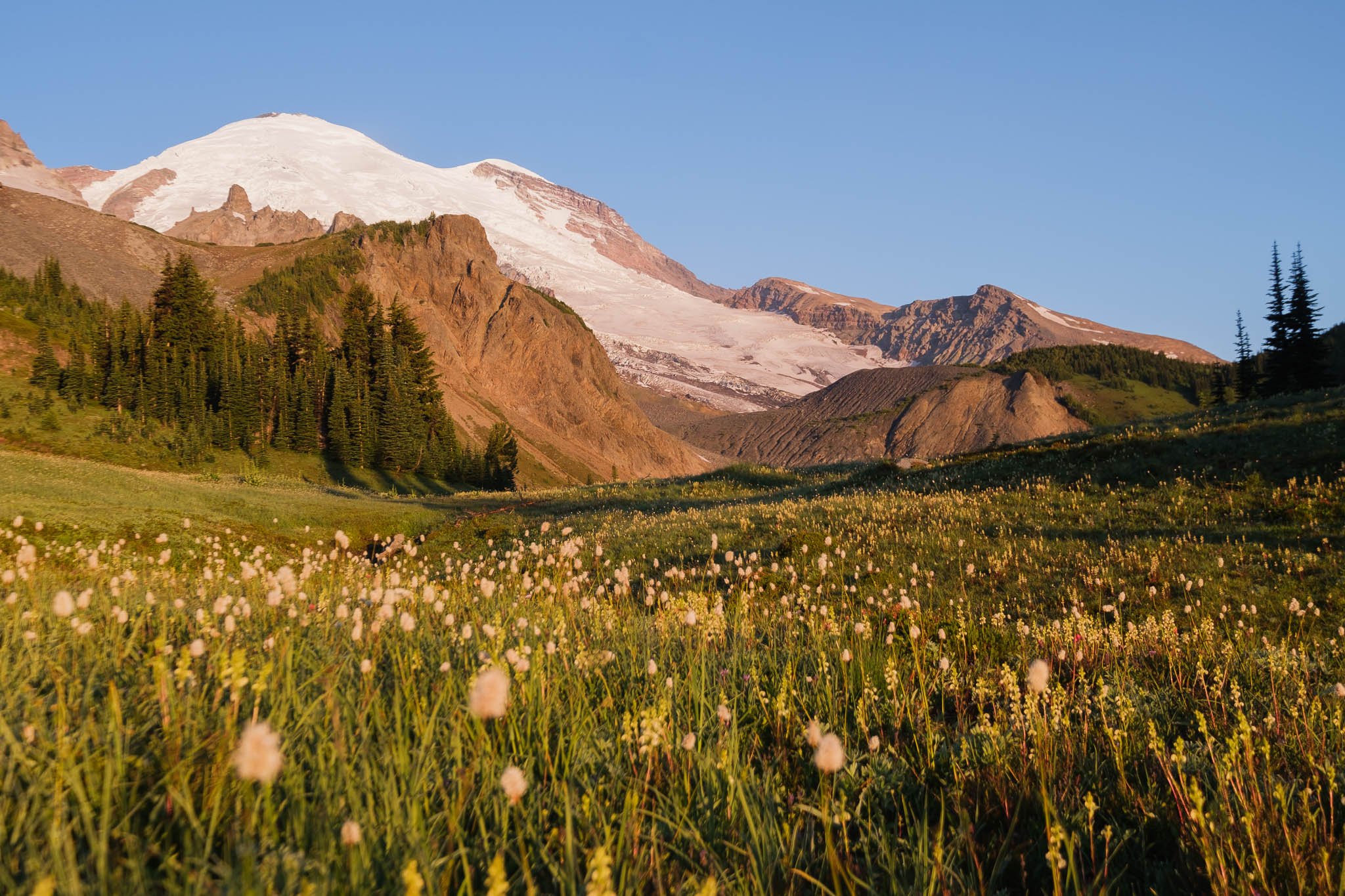
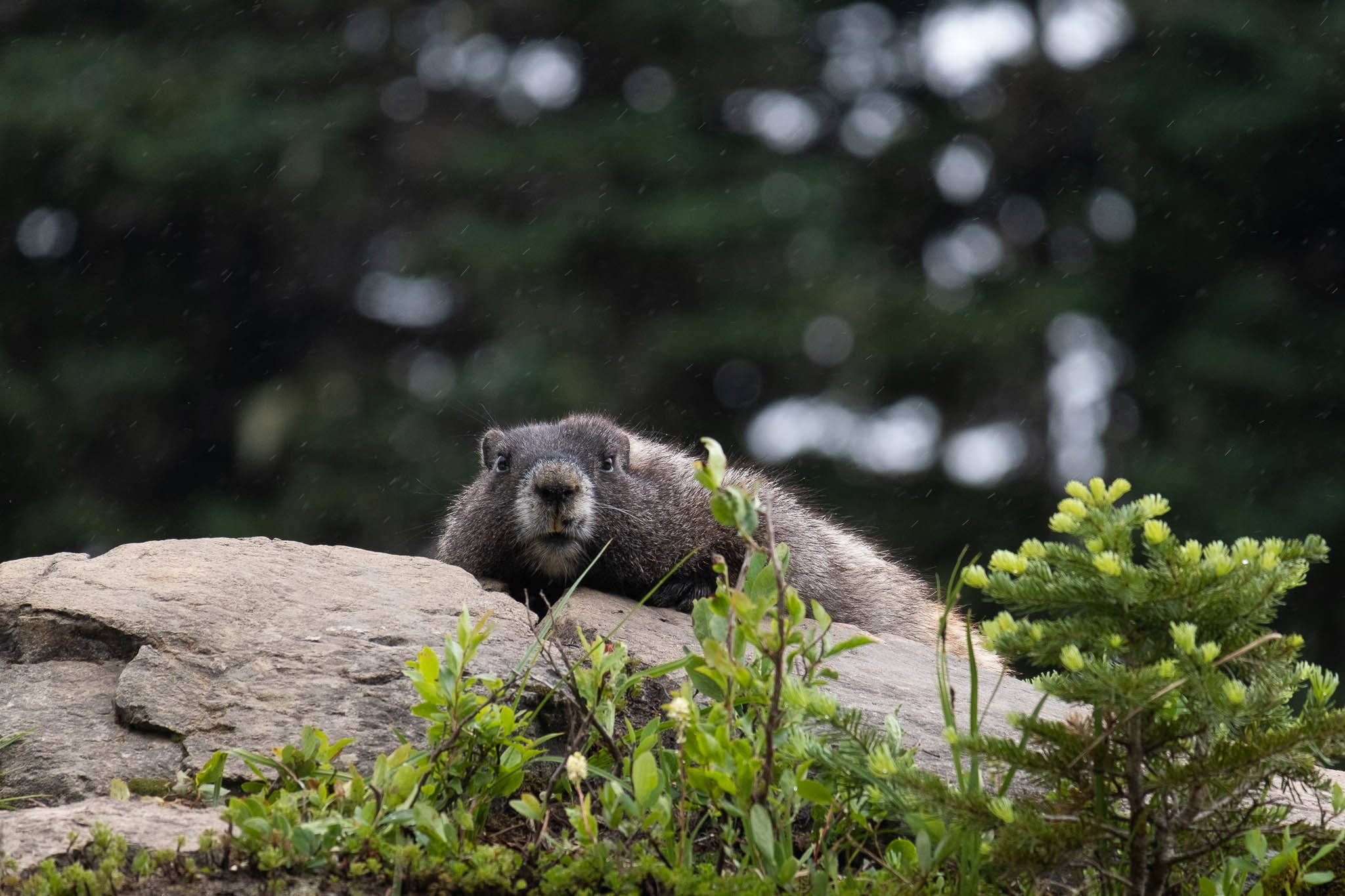
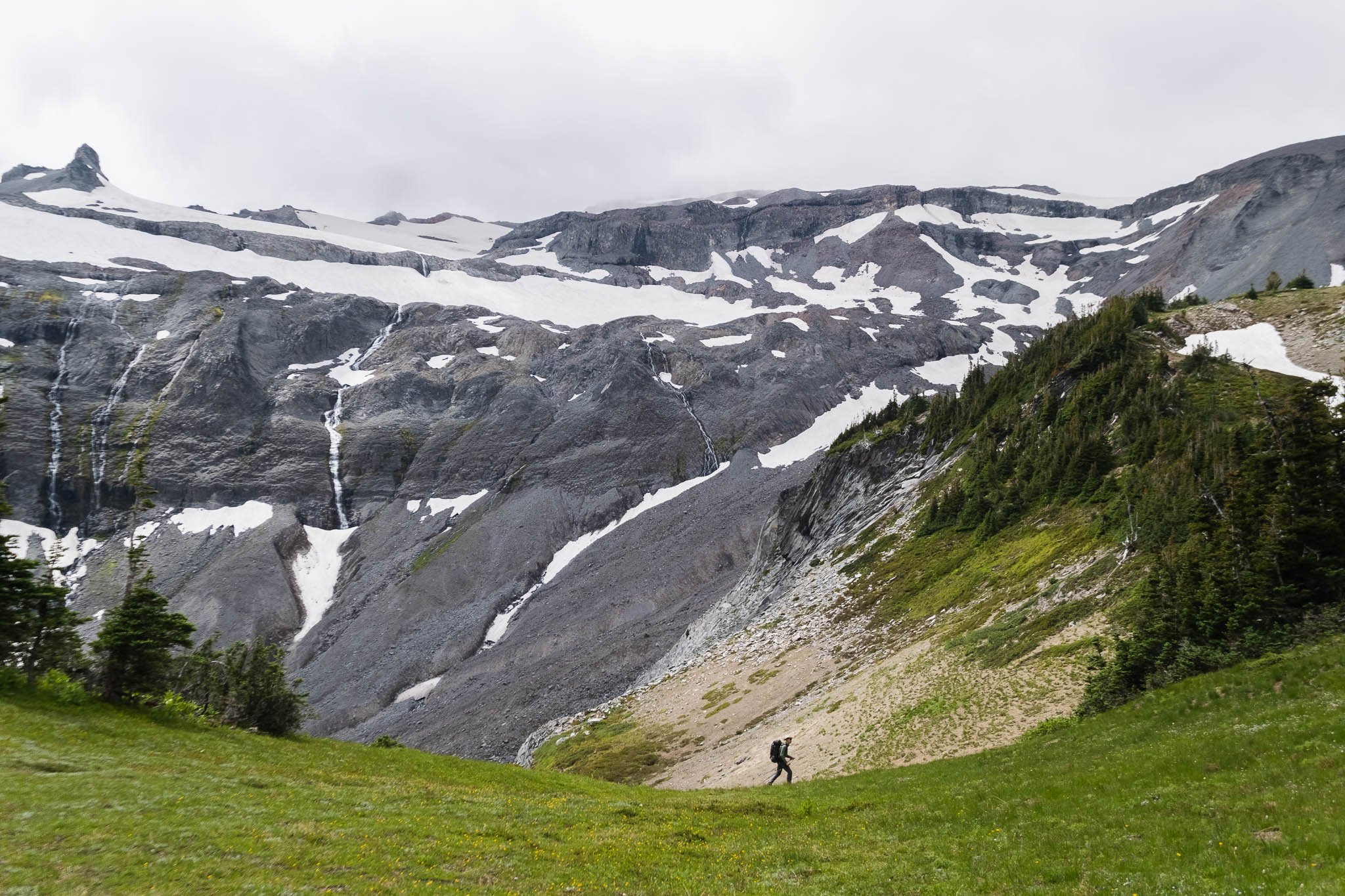
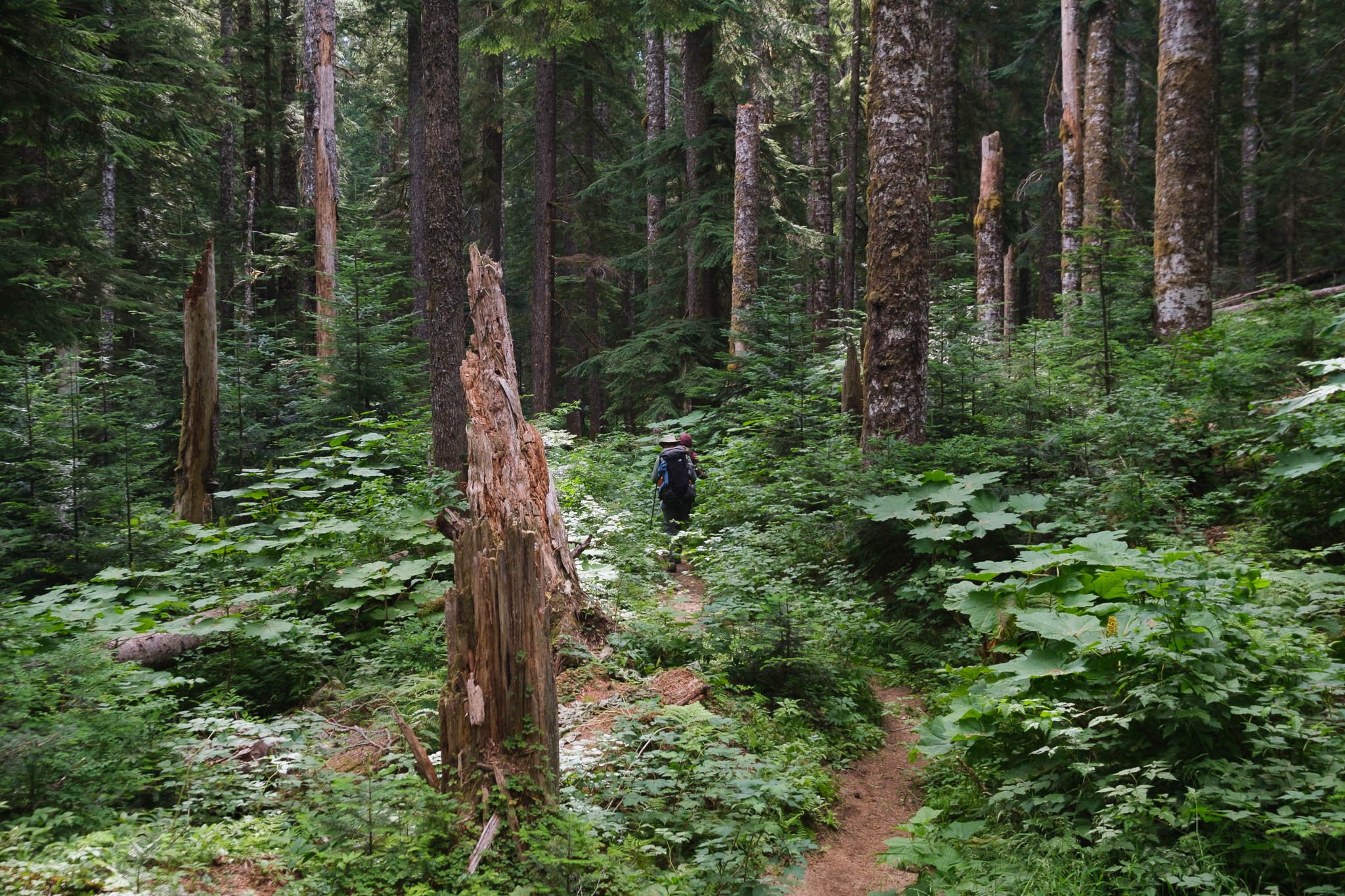
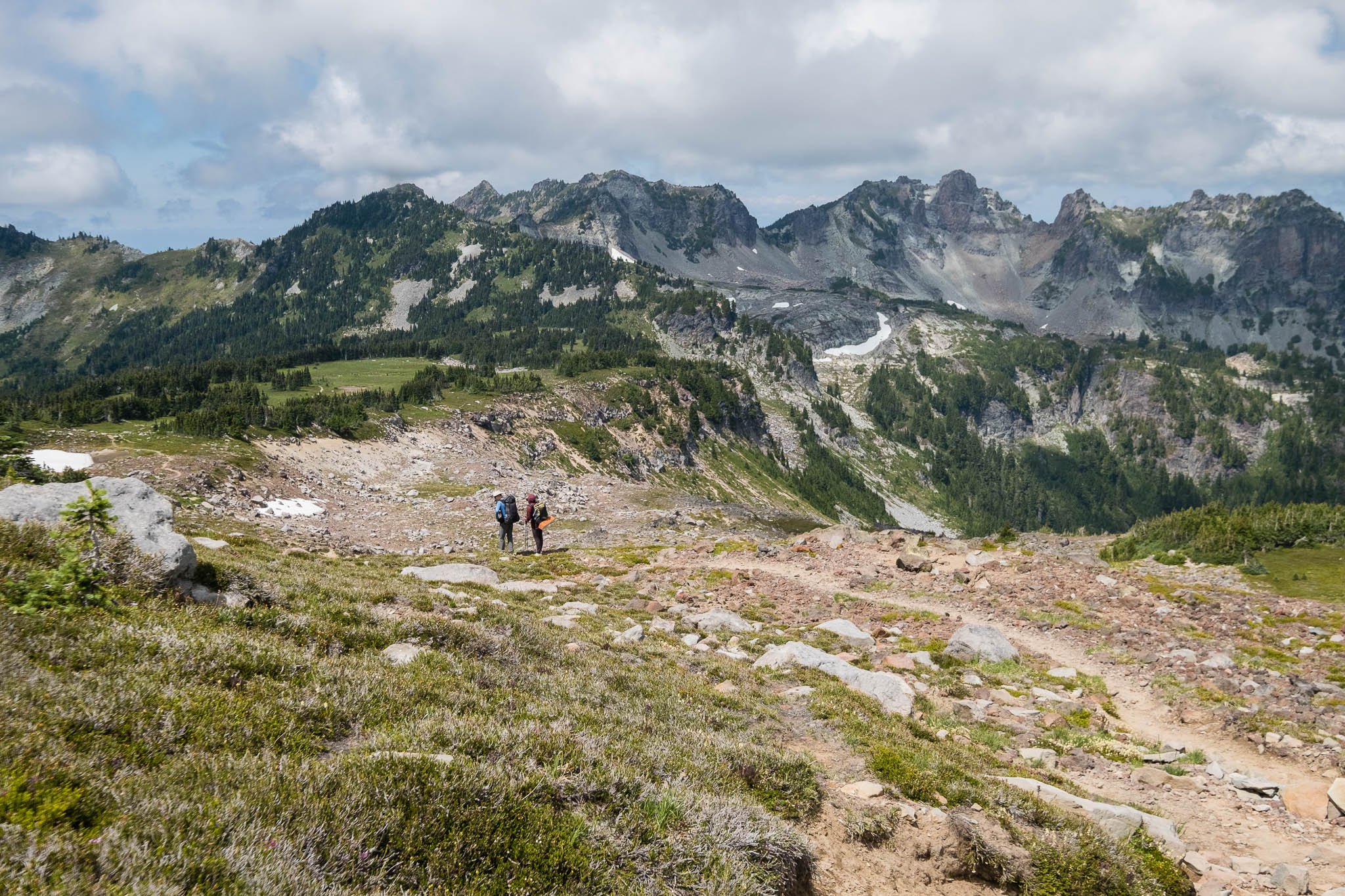
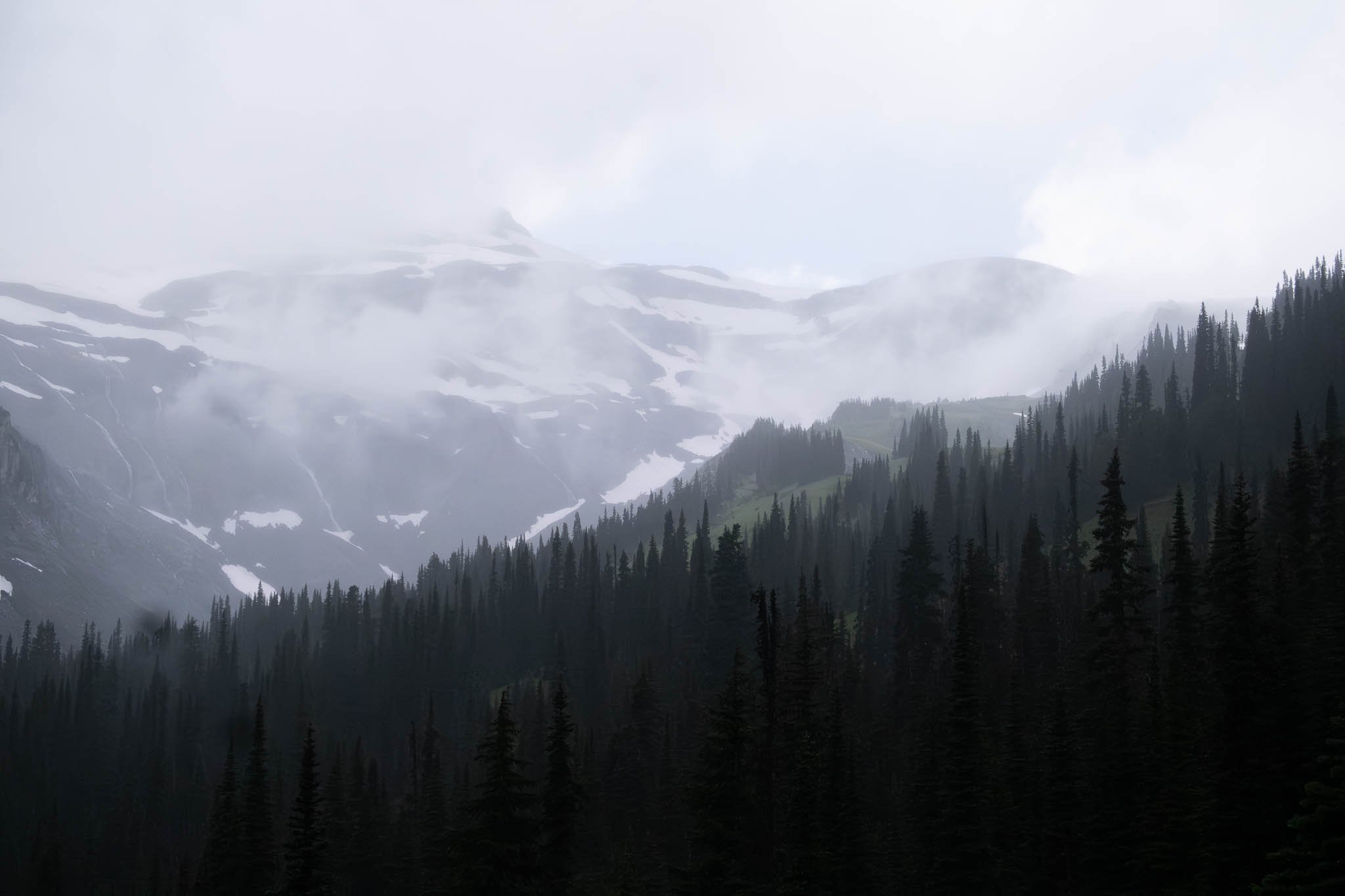
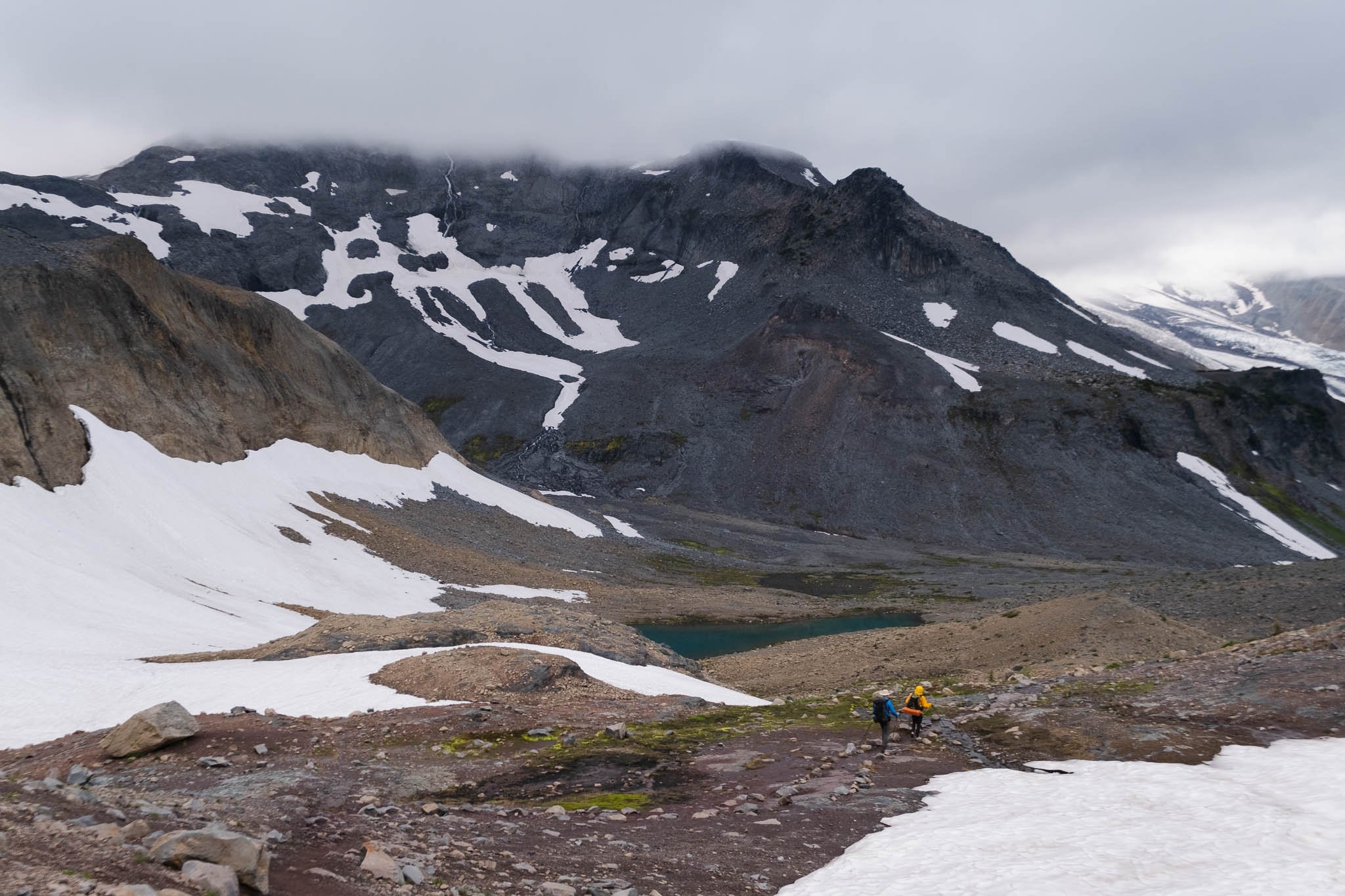
The Wonderland Trail is a 93-mile circumnavigation of Mount Rainier in Mount Rainier National Park, Washington. It typically takes 7-12 days to complete. You'll see Mt. Rainier and its glaciers from all of their angles, as well as forests, meadows, lakes, milky-brown glacial rivers, and wildlife including marmots, mountain goats, and bears (hopefully from a distance). Though the trail is known for its steep ascents and descents as you travel on the flanks of Mt. Rainier, it is very well-maintained. The frontcountry amenities (food, general stores, ranger stations, visitor centers) and multiple food caching locations make this a great introduction to longer distance backpacking trips. I thru-hiked the Wonderland Trail over 8 days in July 2023.
Basics
| Distance | 93 miles |
| Elevation Gain | 23,000 feet |
| Elevation Range | 2,370 feet - 6,750 feet |
| Recommended Time | 7-12 days |
| Type | Loop |
| Trailheads | Longmire, White River, Sunrise, and many more |
| Difficulty | Strenuous |
| Permit | Mount Rainier National Park on Recreation.gov |
| Camping | Designated camping only |
| Highlights | Klapatche Lake, Indian Bar, Panhandle Gap, Summerland, Spray Park, Sunrise |
See full PDF map here Mount Rainier National Park map.
In Red - Wonderland Trail
In Blue - Spray Park Alternate
Table of Contents
Frontcountry Services (Food, Bathrooms, Wifi/Cell Service, Visitor Centers, Power Outlets)
Permit Info
Permits for the Wonderland Trail are handled by Mount Rainier National Park Wilderness on Recreation.gov. The permit process starts around February of each year with the early access lottery. Getting a permit is competitive and requires a good deal of luck.
I’ll summarize the permit process below, but for the most complete information about permits, visit Recreation.gov or call a wilderness ranger if you have questions.
How does the permit work?
You must have a campground reservation for every night you spend on the Wonderland Trail because camping is only allowed at designated campgrounds. Sites within a campground are not assigned.
A majority of the campgrounds are small with only 3-5 sites, meaning competition for permits is fierce. Thus, the more nights you spend on trail, the more campsites you need to book, and the harder it will be to get the itinerary you want. Campgrounds like Indian Bar and Summerland are also popular for out-and-back and section hikes, and are often a bottleneck for putting together a full circuit.
Group Size
The average Wonderland campsite fits up to 5 people and 2-3 tents (more on this under About Wonderland Backcountry Camps). This means on a single permit, you can only have up to 5 people OR you must reserve a group site for groups of 6 or more. Most, but not all, of the campgrounds offer group sites. Check here for the full list of campgrounds and site information.
Getting a Permit Reservations
The best way to get a permit for the Wonderland Trail is to enter the early access lottery on Recreation.gov in February. You do not need an itinerary to enter the lottery, so it’s little effort to enter.
If you are lucky enough to win the early access lottery, then you’ll be assigned a time slot to reserve your itinerary during the early access period between March and April. The earlier your time slot, the more availability there will be. After early access ends, whatever spots are leftover open up to the general public, but it will be unlikely that you can put together a full circuit by then.
In 2023, I won a time slot on the 7th day of the early access period. Although there was still plenty of availability overall when my time slot arrived, Indian Bar and Summerland, both very popular campgrounds, were quite booked up already for late July. Since I wanted both campgrounds on back-to-back nights, that greatly narrowed my itinerary options. I can’t imagine how difficult it would be to get the itinerary you want later in early access, much less after early access.
The 15 here indicates 15 people, which is equivalent to 3 campsites. The remaining 2 campsites are reserved for walk-ups. The “W” indicates that the reservable quota is already booked up and the remaining availability is walk-up only.
This screenshot shows the reservation screen. You will select each night’s camp one at a time to complete your permit reservation. Once you select a camp for a night, you will be shown available camps for the next night. Camps further than 17.5 miles away will always show as not available (this is how the distance limit is enforced online).
Walk-up Permits
One-third of campsites are reserved for walk-up permits. Walk-up permits can only be obtained in-person at a ranger station for a trip starting the same day or the next day.
Note that even if you are the first in line on a given day, that does not guarantee your pick of camps. With weeklong itineraries being the norm, the spots could have already been filled by backpackers with trips starting earlier than you.
Some Last Tips
Live campground availability can be viewed during the early access period on Recreation.gov if you won a time slot. Keep tabs on this so that you can be prepared with alternate itineraries if your first choice itinerary becomes unavailable before your time slot arrives.
You can change a reserved permit using available walk-up quota when you pick up your permit at the ranger station before your trip. For example, we booked Mystic Camp for our 7th night during early access but we changed it to Dick Creek in person. So even if your first choice campsite is booked out online, book a (reasonable) backup and try your luck with the walk-up quota.
During early access, you cannot book campsites further than 17.5 miles apart. This is to discourage people from making unrealistic itineraries. You must make these reservations after early access over the phone or in-person.
BE FLEXIBLE! You can start from trailheads other than Longmire, go clockwise or counter-clockwise, stay at frontcountry campgrounds (Mowich Lake, White River, and Cougar Rock) that offer a portion of sites with first come first serve availability, choose less popular campgrounds, and start on different dates. However, if you are compromising your itinerary so much that it makes you less excited for your trip, it might be worth it to try again a different year.
Views near Spray Park
Making an Itinerary
The Wonderland Trail has so many campsites and entry points to choose from that the combinations can feel endless. I'm going to cover some factors to consider when building an itinerary. I also highly recommend using the Hiking Tahoma Planner, which instantly generates sample itineraries of any length (with all the mileage and elevation gain calculated) that you can then customize. It’s free and created by Mount Rainier enthusiast Shawn Hargreaves.
How Many Days?
Most people complete the trail in 7-12 days, with 9-10 being average. The Wonderland Trail is 93 miles and 23k feet of gain. If you do the math:
7 days: 13.3 miles, 3286’ gain
8 days: 11.6 miles, 2875’ gain
9 days: 10.3 miles, 2555’ gain
10 days: 9.3 miles, 2300’ gain
11 days: 8.5 miles, 2090’ gain
12 days: 7.8 miles, 1917’ gain
Note that while a single day’s stats may look reasonable, don’t estimate the increased difficulty of hiking for many days back to back.
Trailheads
You can start the Wonderland Trail anywhere the trail meets a road, so there are many options for trailheads. These trailheads can be grouped from most developed to least developed as follows:
Visitor centers, food, cell service: Longmire, Sunrise
Frontcountry campgrounds: White River, Mowich Lake
Other trailheads: Box Canyon, Fryingpan Creek, Reflection Lakes
The most popular entry point by far is Longmire. Longmire is bustling with a restaurant, a hotel, a general store, parking, and wifi/cell service. It’s also located at a low point, so you'll be ending your trip on a downhill whichever direction you choose.
Longmire, Sunrise, White River, and Mowich Lake all have similar drive times from Seattle, but the non-visitor center entry points have fewer amenities. For example, Mowich Lake is a campground but only has a pit toilet and no running water.
With all that being said, the features of the trailhead that you choose are hardly important. Instead, prioritize making an itinerary that works best for your hiking mileage. For our itinerary, Mowich worked the best. A plus of not starting at Longmire was having brunch at National Park Inn in Longmire 2 days into our trip!
Views on the descent from Panhandle Gap to Summerland
Best Wonderland Backcountry Camps
While getting any campground is arguably better than getting no campground at all and not being able to do the Wonderland Trail, not all campgrounds are created equal. If you have the luxury of choice, read more about which campgrounds are worth striving for.
Mount Rainier veteran Willis Wall created an incredible resource in the form of video campground tours of every Wonderland Trail backcountry camp (his website). The videos don’t show the surroundings of the campgrounds so it’s hard to tell how nice they are, but I included some of my photos of my favorites below.
The Standouts (I prioritized camping at all of these)
Summerland: located next to a beautiful alpine meadow with panoramic views of Mt. Rainier in its backdrop. The meadows are bursting with wildflowers in July and August.
Indian Bar: located in a meadowed valley with sweeping views of Ohanapecosh Glacier. The glacier feeds the Ohanapecosh River that runs through camp as well as many waterfalls that cascade down the steep valley walls. This camp wins "Most Spread Out" from Willis Wall, and I have to agree. It's spread out and on an incline, so maybe don’t wait until the last minute to make the hike to the toilet.
Klapatche Park: a small, four-site campground located next to a seasonal lake, Aurora Lake. The lake is small so it's usually calm with wonderful reflections of Rainier, especially at sunset. The downside of this camp is that when the lake dries up later in the season, the nearest water source is St. Andrews Lake, a 1.5 mile round trip.
Sunrise at Summerland Camp
Views at Indian Bar camp
This sunset view at Klapatche Park awaited us after an 18 mile day from Mowich Lake.
Other Notable CAMPS
Dick Creek: a quiet, two-site campground with humble valley views. The sites are next to an icy cold and crystal clear terraced creek that flow down the bouldered hillside. It is great for dipping your feet in (or whole body, if you’re brave enough).
Sunrise Camp: true to its name, the Sunrise area of Mount Rainier boasts amazing sunrises. Sunrise Camp itself has no views, but if you follow the Burroughs Mountain trail for a half mile from camp, you’ll reach a viewpoint with panoramic views of Rainier. Head up there at sunrise to see the alpine glow light up the mountain. Also the bear lockers here were much easier to use than janky bear poles.
Golden Lakes: lake access, as well as views of lakes.
Mystic Camp: close to Mystic Lake.
Rosy dawn light from close to Sunrise Camp
NOT PARTICULARLY NOTABLE, BUT STILL NICE (basically the "river" AND "creek" camps)
Paradise River
Maple Creek
Nickel Creek
Pyramid Creek
Granite Creek
Carbon River
Ipsut Creek
Cataract Valley*
Eagle's Roost*
South Mowich River
North Puyallup River
South Puyallup River
*on the Spray Park alternate
Avoid if you can
Devil's Dream: mosquito hell (or heaven?) during bug season. Most of the campsites are also immediately next to the trail and offer no privacy. When we walked by this camp in the late afternoon, we could see everyone inside their tents hiding from mosquitoes.
Cougar Rock, Mowich Lake, and White River: These are frontcountry camps and as such, do not feel like wilderness camps. (I don’t count Sunrise Camp here since the camp is not car-accessible but rather a 1 mile walk from the visitor center.)
Hiking Direction
The clockwise direction is more popular supposedly because the uphills are less steep. Personally, my knees would take steep uphills over steep downhills any day. After hiking the trail myself, the direction doesn't seem to matter much since the steepness is about the same in either direction. They are both hard.
My 8-Day Itinerary
Day 1 Mowich Lake to Klapatche Park: 17.9 miles, +5200 -4600
Day 2 Klapatche Park to Pyramid Creek: 13.1 miles, +3600 -5400
Day 3 Pyramid Creek to Maple Creek: 14.2 miles, +3000 -4000
Day 4 Maple Creek to Indian Bar: 10.4 miles, +4300 -2000
Day 5 Indian Bar to Summerland: 4.7 miles, +2100 -1200
Day 6 Summerland to Sunrise: 10.5 miles, +2800 -2400
Day 7 Sunrise to Dick Creek: 12.4 miles, +2200 -5000
Day 8 Dick Creek to Mowich Lake: 9.8 miles, +4000 -3200
My group went counter-clockwise starting from Mowich Lake. We had a time constraint of 8 days and wanted to camp at the top 3 campgrounds: Summerland, Indian Bar, and Klapatche Park. Because Summerland to Indian Bar would only be a 4.7 mile day, we would have to make up that mileage another day. I feel like I tried every possible permutation of trailheads and hiking directions using the Wonderland Itinerary Planner, and the most doable option (aka no 6k'+ elevation changes in a day) that still had all 3 camps started from Mowich Lake.
I ended up liking our itinerary a lot. Our longest day was the first day when our legs were fresh. The segment from Mowich Lake to Klapatche Park is also less interesting, with only one brief view of Mt. Rainier before Klapatche Park. Knocking out a big chunk of the west side in a day allowed us to take our time on the highlights of the Wonderland Trail between Nickel Creek and Granite Creek. If you don't have a time constraint of 8 days, I would absolutely recommend staying at Golden Lakes on night 1 rather than having an unnecessarily brutal first day.
A limitation of having long days is that the online system does not allow for booking consecutive camps over 17.5 miles apart. Fortunately for us, our 17.9 mile day was on the first day and not between camps, so by a sort of loophole we were able to reserve it during early access.
Spray Park Alternate
The Spray Park alternate refers to the segment between Carbon River camp and Mowich Lake that goes through Spray Park instead of over Ipsut Pass. I'd say just do it! It was an easy choice for us since we were prioritizing scenery. It's a little more effort in terms of elevation gain (~800 ft), but the Spray Park alternate takes you to a gorgeous meadow with up close views of Mt. Rainier. Both the original route over Ipsut Pass and the alternate over Spray Park have a significant amount of climbing, and having Spray Park at the top of the climb was a great reward!
Incredible views of Mt. Rainier at the top of the Spray Park climb
When to Hike
Conditions may vary wildly depending on the year, so it's good to follow recent conditions in the Facebook group if you are hiking early or late season. Generally, the gist is:
June
Expect snow travel
Rivers may be impassable if bridge repairs are still in progress
The only notable snow in late July 2023 was near Panhandle Gap. Not an issue for us, but it definitely would have been sketchy earlier season.
July
Early July: same as June, depending on the year
Long daylight hours
Bugs
Wildflowers
August
Hopefully fewer bugs
Wildflowers fading as the month goes on
Late August: risk of smoke from fire season
September
Less crowded, fewer bugs
Drier. Water sources may be scarce.
Fewer hours of daylight
Risk of smoke from fire season
Risk of snow or other inclement weather
Fall colors
We decided on the last week of July and the conditions were perfect. We had one day of rain and the snow on trail was almost completely melted. Daytime temperatures were pleasant in the mid 60s to low 70s and wildflowers were abundant. The only unbearable bugginess we experienced was around Devil's Dream (try to avoid camping there).
Beargrass blooms near Spray Park
About Wonderland Backcountry Camps
There are 18 campgrounds along the Wonderland Trail. Each site is numbered by a signpost, and sites within a campground are not assigned. The size of a campground varies from as small as 2 sites (Dick Creek) to larger than 7+ sites. While some campgrounds have nicer surroundings than others, most campsites are sheltered by trees and have no views. Here's a little more about what to expect.
Individual Sites
The campsites have space to comfortably fit two 2p tents. No promises for 3 tents, but anecodotally, our group of 4 managed to squeeze 3 2p tents at every campsite we stayed at.
Here is a smattering of photos from the campsites we stayed at or passed by (from left to right): Indian Bar, Maple Creek, South Mowich River (the only individual site shelter), Summerland, Pyramid Creek, Sunrise.
Group Sites
The majority of campgrounds on the Wonderland Trail have at least one larger group site that can accommodate 6-12 people. The group sites at Summerland and Indian Bar were 3-sided shelters and would definitely be a luxury in bad weather.
Sitting outside the group site shelter at Indian Bar (book this if you are a group of 6+!)
Food Storage
Every campground has at least one bear pole or locker, meaning you do not need to bring a bear can on this trip! The bear pole is a metal pole with several ridged rods crossed at the top. To hang your food, you use a different metal pole to hoist your food bag up. The bear poles are quite tall, and a long metal pole with many pounds of food on one end can be somewhat unwieldy to handle.
TOILETS
Every campground has a pit toilet. The toilets are usually situated a few minutes’ walk away from the campsites. Some are fully enclosed with a door, while some are an elevated box just out in the open. While the doored ones may seem nicer, I often preferred the open-air ones since they don’t trap smells as much and they aren’t dark.
A trowel is not really needed on the Wonderland Trail as ideally you'll be doing your poop business at a campground. On most days, we passed multiple campgrounds during the hiking day, and we tried to use the pit toilets whenever possible.
From left to right, some toilet examples: Summerland, South Puyallup River, Cataract Valley (the toilets here are questionably placed back-to-back), Dick Creek, Pyramid Creek.
Water
Although most campgrounds are strategically located next to a natural water source, some water sources are only semi-permanent and may dry up later in the season. The ranger will have the best information on water sources when you pick up your permit.
Klapatche Park: the only water source is Aurora Lake, which is at best a pond, and at worst, teeming with tadpoles or dried up. When Aurora Lake is dry, you will need to hike 0.75 miles one way to St. Andrews Lake. This is not a big deal if you are going clockwise as you can fill up with water before you get to camp.
Devil’s Dream: the water source is a stream that dries up in August. There are water sources before and after within a mile.
Food Caching
There are three food cache locations spaced pretty evenly apart on the Wonderland Trail: Longmire, White River, and Mowich Lake. Usually, you will start at one of these trailheads and cache food at the other two. We only carried a maximum of 3 days of food at a time thanks to our two food caches.
My cache-planning spreadsheet
You can either drop off caches in person or ship them. We did not consider dropping off caches in person because driving distances are 2+ hrs in between cache locations, so dropping off 2 caches would have taken the whole day.
Caches need to be stored in a hard-sided lidded container. People usually use plastic 5 gallon buckets that can be found at hardware stores. For detailed instructions on food caching, visit the NPS site.
My group of four shared three buckets: 2 for the first resupply for a four day segment, and 1 for the second resupply for a 1.5 day segment. We also enjoyed real (non-backpacking) food when we picked up our caches when possible: at Longmire (National Park Inn) and at Sunrise (Sunrise Day Lodge). Make sure to check the hours before you go!
IDEAS FOR FOOD TO CACHE
While backpacking food usually needs to be (1) shelf-stable (2) lightweight (3) not bulky, for your cache, it really only needs to be (1). So go wild and pack yourself some well-deserved treats! Some ideas:
Drinks: alcohol, coconut water, fruit juice, soda, energy drinks, plant-based milk. I cached a carton of coconut water. Even in July, my coconut water was fridge-cold when I picked it up from the shaded White River cache midday. It tasted AMAZING.
Tinned fish: tuna, sardines, anchovies (the frontcountry has trash cans!)
Bulky snacks: chips, packaged roasted seaweed, popcorn, etc.
Canned/jarred anything: soups, salsa, fruit, beans, veggies (Trader Joes has some good ones like their Grecian Style eggplant)
Shelf-stable, vacuum-sealed foods: packaged soups, Madras lentils, etc.
non-food items TO CACHE
Extra fuel CANNOT be mailed. it must be delivered in person. If you start out with a full 4 oz canister though, this is not super necessary.
Extra power bank
More socks and underwear
More toilet paper (or just restock from the bathrooms at Sunrise, Longmire, and White River)
Tip: if it’s possible, plan harder hiking days before a cache pick up
A fun side note about food caches is that there is usually a discard bucket where hikers can leave food they don't want and take food left by others. We ended up swapping several meals and bars and got to try out some new backpacking food brands!
From left to right: some goodies from the discard bucket at White River, goodies from my own cache, our obsessively-taped and labelled cache bucket.
What to Bring
For my complete list of backpacking gear recommendations, check out my gear page. Here, I will highlight what I think is notable for this trip. (Disclosure: I use affiliate links below. If you do end up making a purchase through them, thank you for supporting my blog!)
Waterproof food bag: Bear poles are the primary method of food storage, so you need a bag that has a handle and is ideally waterproof in case it rains overnight. I like to use an ultralight rolltop drybag by Osprey that weighs just 1 oz.
Charger: I need power for my phone, Garmin watch, camera, so I usually bring a power bank for anything longer than an overnight trip. For the Wonderland trail, I used 2 of these Anker PowerCore 10000mAh Portable Charger.
Hiking poles: Hiking sticks are super useful on the Wonderland Trail. They let my arms do some work on the ascents and take some weight off my knees on the descents. I use the Cascade Mountain Tech Carbon Fiber Poles, which are affordable and lightweight carbon fiber poles.
Rain protection: It is not unlikely that you will encounter rain at some point on the Wonderland Trail, so I would recommend bringing a Goretex shell like the Arcteryx Beta jacket, a cheap ultralight favorite from Frog Toggs, or even a plastic poncho.
Water filter: There are plentiful water sources on the Wonderland Trail. Carrying a lightweight and easy to use water filter like the Katadyn BeFree 1.0L Water Filter is extremely convenient for topping up water throughout the day while on trail.
Bug head net: A head net can be a huge relief when bugs are bad. I bring the Coghlan's No See Um Headnet on every trip I go on since it weighs less than an ounce.
Rainy weather as we descended into Indian Bar
Trail Highlights and Lowlights
Highlights
Views upon views of Mount Rainier and its glaciers. You'll have many opportunities to see the majestic glaciated Rainier. From Klapatche, Summerland, and Sunrise, watch the mountain light up scarlet at sunrise and sunset. Winthrop Glacier and Carbon Glacier reach down the mountain and end just above where the trail crosses over the churning milky-brown rivers. It was humbling to see these craggly masses of ice and walk through the landscapes they have shaped.
Wildlife. We saw lots of marmots, a black bear, and a mountain goat. Other common spottings include: pikas, deer, elk, ptarmigans, and owls.
Designated campgrounds make the camping part simple. The campgrounds are minimal in amenities, but having a campsite, a pit toilet, and a bear hang pole makes the end of the day that much simpler. No need to worry about picking a good spot to set up your tent!
Trail culture. A lot of the hikers you pass on the Wonderland Trail are also doing the Wonderland Trail, which means we saw a lot of familiar faces throughout our hike. We leapfrogged a group going the same direction as us multiple times, and recognized clockwise hikers we passed all the way on the other side of the loop.
Snack break along the trail above Berkeley Park in the Sunrise area of Mount Rainier
The bridged West Fork White River crossing
Lowlights
Lots of elevation gain and loss. This isn’t a lowlight as long as you like a challenge! The Wonderland Trail is rarely flat. If you're not going up, you're going down. It helps a lot to be in good shape and to have as light of a pack as possible.
Lack of solitude, especially in frontcountry areas and backcountry campgrounds. Sections of the trail that are close to roads and trailheads are more crowded with day hikers, such as Longmire to Reflection Lakes and White River to Sunrise and the Burroughs Mountain trail. Camping in backcountry campgrounds means that you are always camping near other groups. I didn't mind this personally, but it is a very different experience from non-designated backcountry camping where it's rare you'll camp near another group!
Long forested sections. Although there is usually at least one standout, above-treeline view per day, there were some days that were mostly in the trees. That's not to say I didn't enjoy hiking in the trees. I was very thankful for shade on most of the hard ascents and descents, and the forests were beautiful. But it can get a little monotonous, and I would be lying if I said a lot of it didn't blur together.
Foresty sections between Maple Creek and Indian Bar
Frontcountry Services
Tthe ability to resupply and access other services are a unique feature of the Wonderland Trail that make it a more approachable long trail.
Food
In addition to being able to resupply by preparing your own food caches, there are also options to buy food on the Wonderland Trail.
Longmire: The National Park Inn has an outside deck with tables and chairs, as well as a restaurant with sit-down food. The restaurant serves breakfast, lunch, and dinner, and there’s a small grab and go fridge in the lobby with various drinks and snacks. The general store in Longmire is small but has some drinks, snacks, and hiking/backpacking essentials like first-aid, sunblock, bug repellent, etc.
Sunrise: The Sunrise Snack Bar is located inside the Sunrise Day Lodge. It's counter-serve only and has a pretty basic menu including burgers, hot dogs, soup, soft serve, etc. We arrived in the afternoon hoping to eat an early dinner there, but they were close to selling out of most items. The Sunrise Day Lodge also has a large souvenir shop that sells grab and go food such as salads, sandwiches, chips, crackers, and other snacks. We ended up cobbling together a dinner of chili, snacks and grab and go salads.
(Actual) Bathrooms
You’ll come across several bathrooms with running water when you pass through the frontcountry. I liked to wash my hands and shirt with soap and wipe myself down with paper towels. There are NO public showers on the Wonderland Trail and the cold water swims can only keep the body odor away for so long, so this is how I cope.
White River, Cougar Rock: flushing toilets and sinks in the campground bathrooms.
Sunrise, Box Canyon: flushing toilets and sinks for day hikers by the parking lot.
Longmire: flushing toilets and sinks for day hikers, as well as in the National Park Inn for diners.
Wifi/Cell Service
I usually keep my phone on airplane mode when I'm hiking, but it was nice to be able to update my family when I got cell service or wifi in the frontcountry. Longmire had Wifi near the Longmire Museum, and Sunrise had usable cell service at the visitor center.
Visitor Centers
Sunrise Visitor Center is the largest visitor center on the Wonderland Trail. The visitor center is actually 0.5 miles off the Wonderland Trail, but I thought it was worth the detour to get real food. We were ending our day at Sunrise, so we dilly dallied a while looking at the visitor center exhibits and flipping through the wildflower and mushroom books. There’s also the Longmire Museum at Longmire. It’s right on the trail, smaller, and more focused on local history.
Power Outlets
I recommend bringing a portable battery pack rather than counting on power outlets, but it’s good to know if you're in a pinch.
Longmire: outlets inside and outside of the National Park Inn
Cougar Rock: outlets in the bathroom
Sunrise: at least one outlet in the restaurant area
Resources
Can’t find the answer to your question online? Definitely ask in the Facebook group. From itinerary critique to up-to-date trip reports, the people in the group are very knowledgable and enthusiastic to help!
Hiking Tahoma Planner: an essential itinerary planner created by Shawn Hargreaves. This is the easiest and most no-nonsense itinerary planner out there. The Wonderland camps in the dropdown are also sorted in clockwise fashion, so it’s easy to know which camp comes next if you’re trying out multiple itineraries.
Wilderness permit reservations on Recreation.gov
Wilderness permit info on NPS.gov
Wilderness permit FAQ on NPS.gov
Mount Rainier Wilderness Trip Planner Map: contains a park map, # individual sites, # group sites
Mount Rainier Park Maps the official NPS maps consolidated by NPMaps.com
Operating Hours and Seasons (of frontcountry services)
